September – GORS Conference, Damascus, Syria
|
|
Federico A. Buccellati
“Tell Mozan: An Archaeologist's take on Remote Sensing”
|
October 16 – Museum of the American University of Beirut, Beirut, Lebanon
|
|
Giorgio Buccellati, Marilyn Kelly-Buccellati, Federico A. Buccellati and Jamal Omar
“Urkesh: At the Wellsprings of Hurrian Civilization”
|
November 9 – Opificio delle Pietre Dure, Florence, Italy
|
 |
Giorgio Buccellati and Marilyn Kelly-Buccellati
“Archeologia e conservazione a Tell Mozan/Urkesh (Siria), la più antica città hurrita”
|
Back to top
2007
February 24 – ARCANE JZ Group, Frankfurt am Main, Germany
|
|
Federico A. Buccellati
“Mozan - Urkesh: Presentation for the 1st ARCANE RG08 Workshop”
|
April 27-28 – Real Time Link between Field Recording and Publication: Digital Archaeology at ancient Urkesh Seminar, Society for American Archaeology, Austin (Texas), USA
|
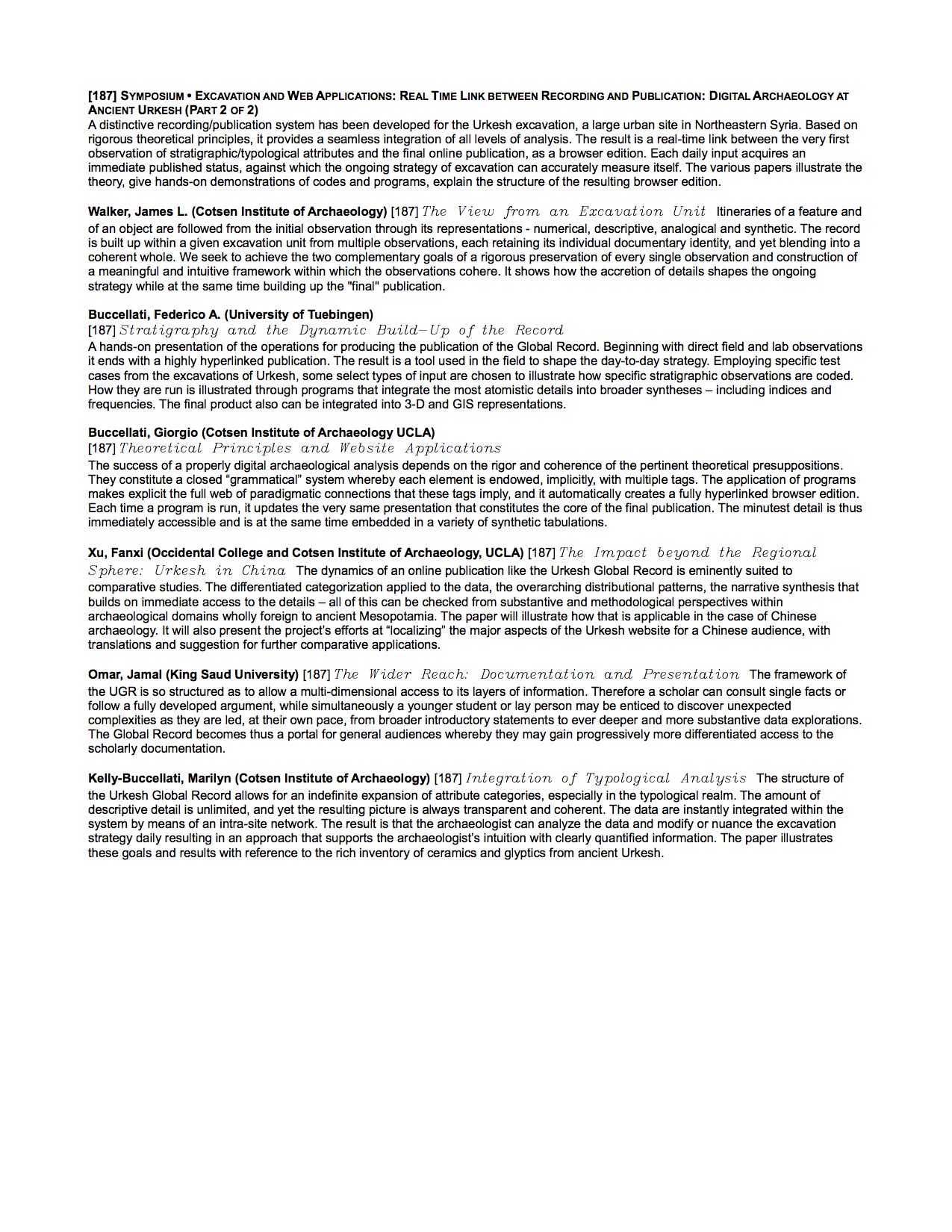 |
Flyer
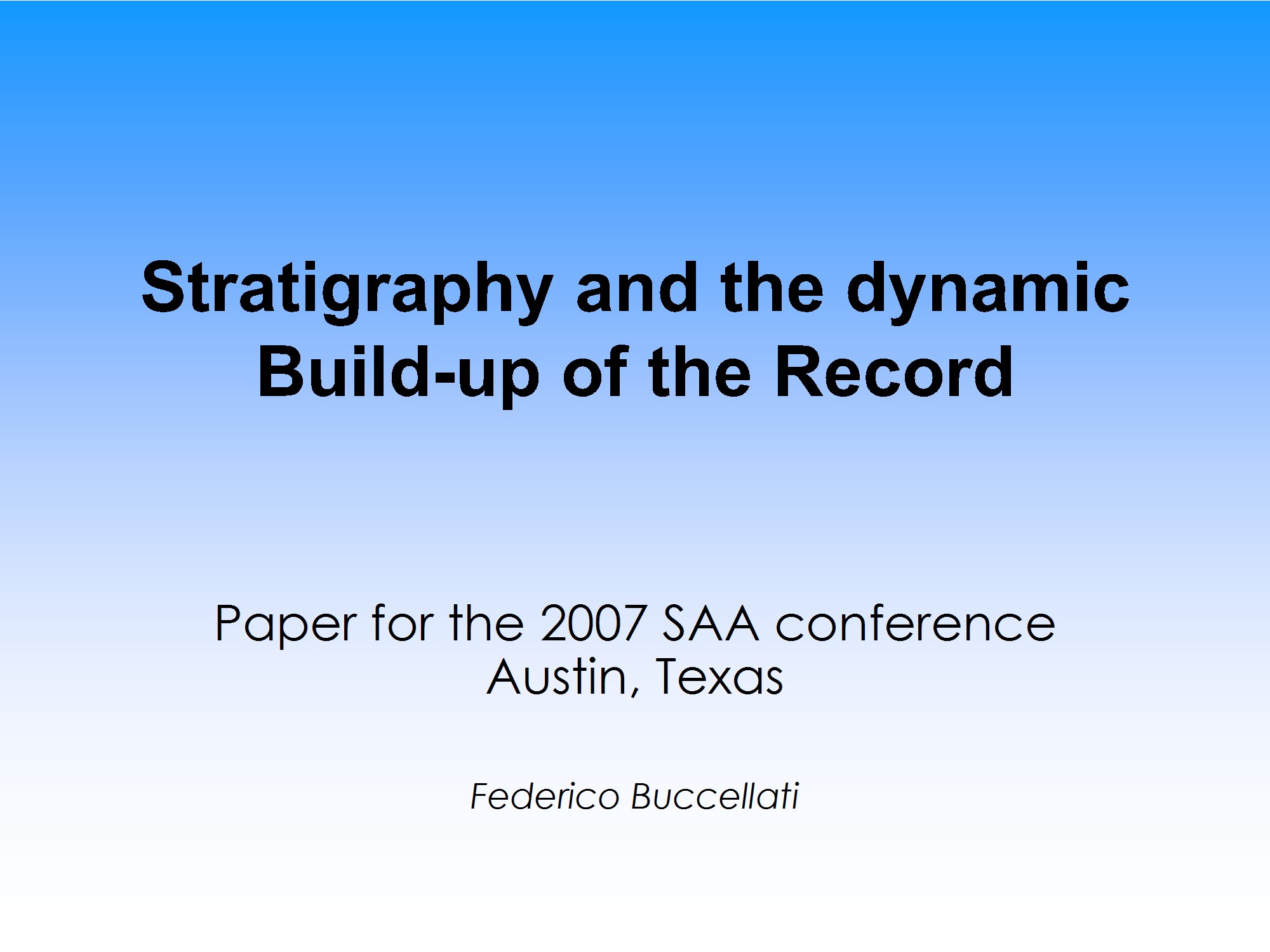
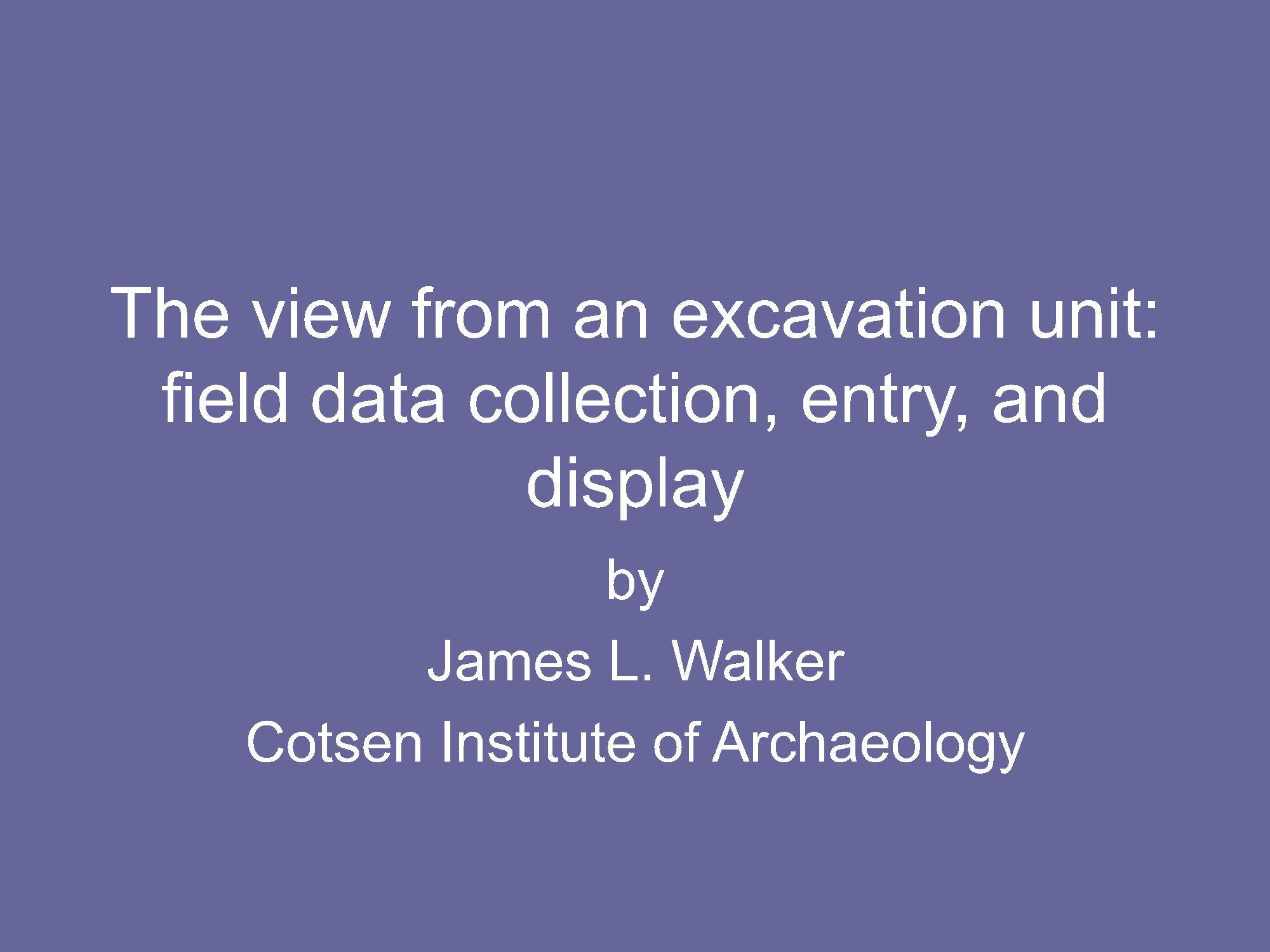


|
Federico A. Buccellati
“Stratigraphy and the dynamic Build-up of the Record”
PDF of the slides available at this link.
James L. Walker
“The View from an Excavation Unit”
PDF of the slides available at this link.
Giorgio Buccellati
“Theoretical Principles and Website Applications”
PDF of the slides available at this link.
Fanxi Xu
“The Impact beyond the Regional Sphere: Urkesh in China”
Jamal Omar
“The Wider Reach: Documentation and Presentation”
Marilyn Kelly-Buccellati
“Integration of Typological Analysis”
PDF of the slides available at this link.
|
Back to top
2008
May 6-8 – ICAANE, Rome, Italy
|
|
Federico A. Buccellati
“The Monumental Temple Terrace at Urkesh and its Setting - Recent Research at Tell Mozan, ancient
Urkesh”
“Instruments for the Communication of Archaeological Heritage – Perspectives and new Directions as seen
from the Context Of Tell Mozan” |
September 20 – The Minnesota Chapter of the Society of Architectural Historians, Minnesota, USA
|
|
Rick Hauser
“Key to the Past: Performing the Built Environment in Very Ancient Times”
|
Back to top
2009
February 4 – Metropolitan Museum of Art, New York, USA
|
 |
Giorgio Buccellati
“When are the Hurrians Hurrian? The Persistence of Ethnicity in Second Millennium Urkesh”
|
April 23 – University of California-Merced, California, USA
|
|
Federico A. Buccellati
“Tell Mozan, ancient Urkesh and Archaeology in Syro-Mesopotamia”
|
October 20 – Rotary Clubs of Conegliano and Vittorio Veneto, Conegliano, Italy
|
|
Giorgio Buccellati, Marilyn Kelly-Buccellati, Federico A. Buccellati, Patrizia Camatta
“Il presente, filtro del passato - Esperienze archeologiche in Siria”
|
December 4 – Universitá di Pavia, Dipartimento di Scienze dell'Antichitá, Pavia, Italy
|
|
Patrizia Camatta
“Applicazione del sistema ai dati architettonici: la grande Terrazza Templare di Urkesh”
|
December 10 – Milan Statale University, Milan, Italy
|
|
Federico A. Buccellati
“3D, Ricostruzione e Documentazione a Tell Mozan”
“Fotografia e Documentazione”
|
December 11 – Pavia University, Pavia, Italy
|
|
Federico A. Buccellati
“La fotografia: innovazioni tecniche delle foto con l'aquilone e metodi di utilizzazione digitale”
“Sviluppi in corso: integrazione dei dati 3D nella codifica dello Urkesh Global Record” |
Back to top
2010
June 25 – University of Heidelberg, Heidelberg, Germany
|
|
Federico A. Buccellati
“Seats of Power: The Architecture of Politics and Religion at ancient Urkesh” |
November 19 – ASOR Annual Meeting, Atlanta, GA, USA
|
|
Rick Hauser
“Reading Figurines: Animal Representations in Terra Cotta from Urkesh, the First Hurrian Capital (2450 BCE)” |
Back to top
2011
n.d. – University of Haifa, Haifa, Israel
|
|
Rick Hauser
“Reading Figurines: a new methodology”
|
May 5 – Goethe Universität, Frankfurt am Main, Germany
|
|
Federico A. Buccellati
“Three-dimensional Volumetric Analysis in an Archaeological Context”
|
June 16-17 – Roma Tre Università, Rome, Italy
|
|
Federico A. Buccellati
“Archaeological Parks and Beyond”
“Monumental Architecture and the Urban Environment - Presenting the 'Vision' of a City”
Handout
|
July 5 – Rencontre Assyriologique Internationale 57, Rome, Italy
|
|
Rick Hauser
“Reading figurines from Ancient Urkesh (2450 BCE): A New Way of Measuring Archaeological Artifacts with Implications for Historical Linguistics“
Abstract |
October 20 – Università degli Studi di Napoli Federico II, Naples, Italy
|
|

|
Giorgio Buccellati and Marilyn Kelly-Buccellati
“Il 'Gigante addormentato'. Gli scavi di Tell Mozan (Siria), antica Urkesh: sintesi e ultime scoperte”
Handout
|
December 5 – Brown Bag Lecture, Boston University, USA
|
|
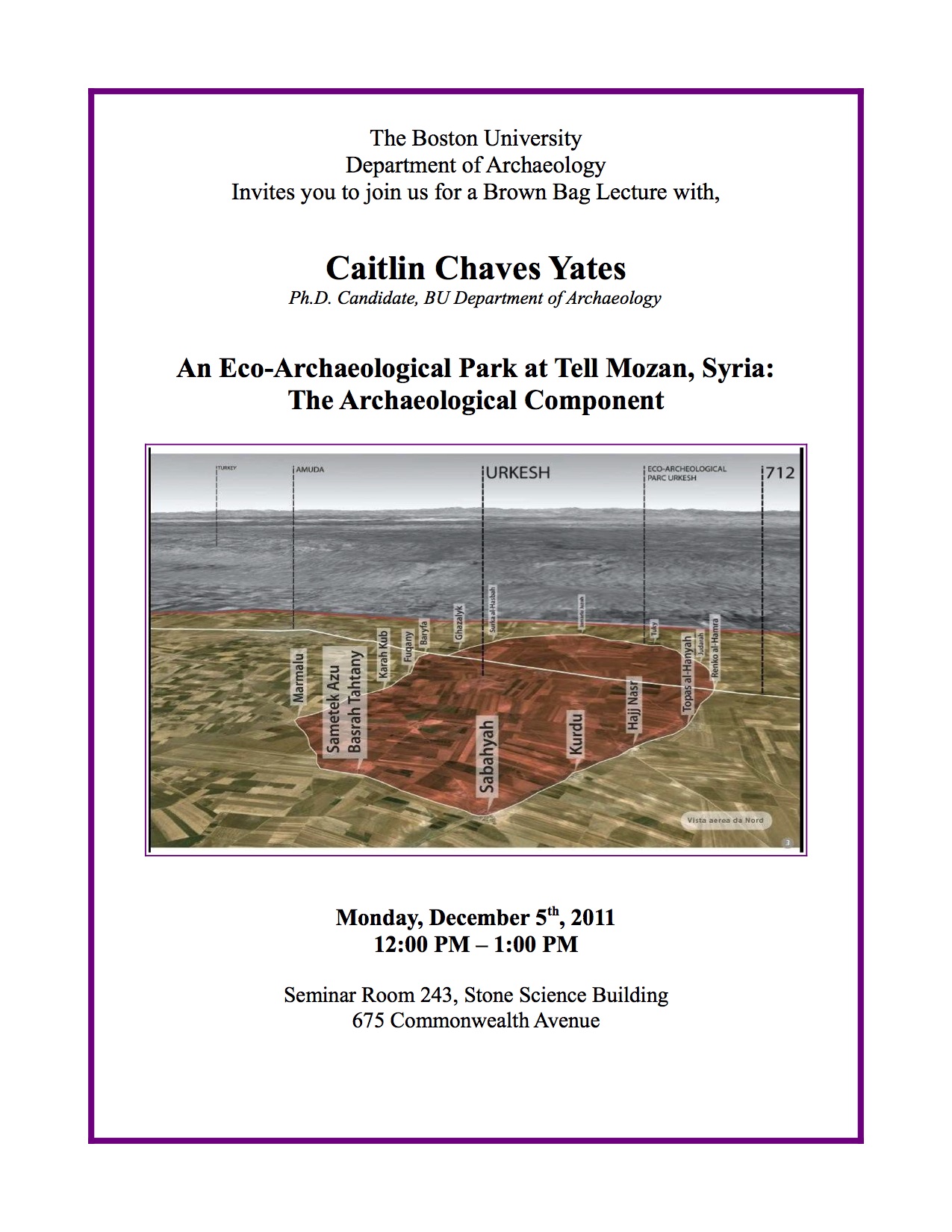
|
Caitlin J. Chaves Yates
“An Eco-Archaeological Park at Tell Mozan, Syria: The Archaeological Component”
|
Back to top
2012
May 2-3 – ICAANE 6, Warsaw, Poland
|
|
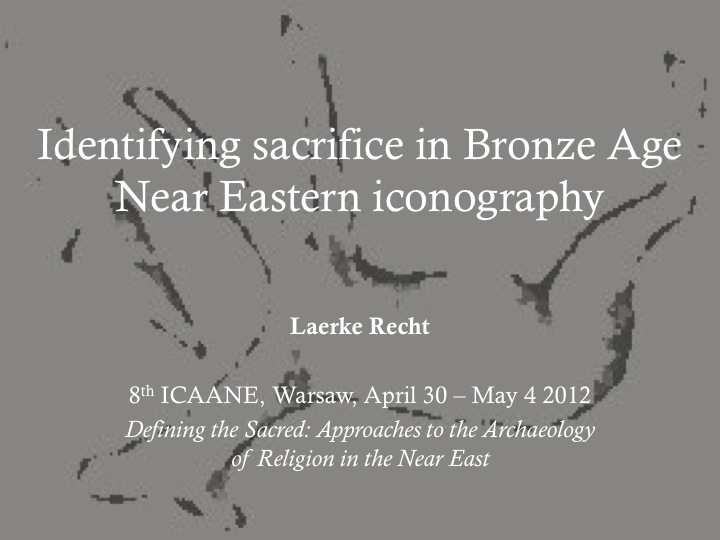
|
Laerke Recht
“Identifying sacrifice in Bronze Age Near Eastern iconography”
Abstract
|
|
|
|
Patrizia Camatta
“High Temples in the Northern Mesopotamian Urban Landscape”
Abstract
|
|
|
|
Federico A. Buccellati
“Diachronic Developments at the Central Monumental Complex of Ancient Urkesh (Tell Mozan)”
Abstract
|
May 8 – Freie Universität Berlin, Die Hurritische Überlieferung, Berlin, Germany
|
|
|
Patrizia Camatta
“Die Tempelterrasse von Tell Mozan im Vergleich zum mesopotamischen Befund”
|
June 6 – Goethe Universität, Frankfurt am Main, Germany
|
|
|
Federico A. Buccellati
“The Analysis of Volumes in Architecture The Case of Tell Mozan”
|
June 13 – Università Ca' Foscari, Venice, Italy
|
|
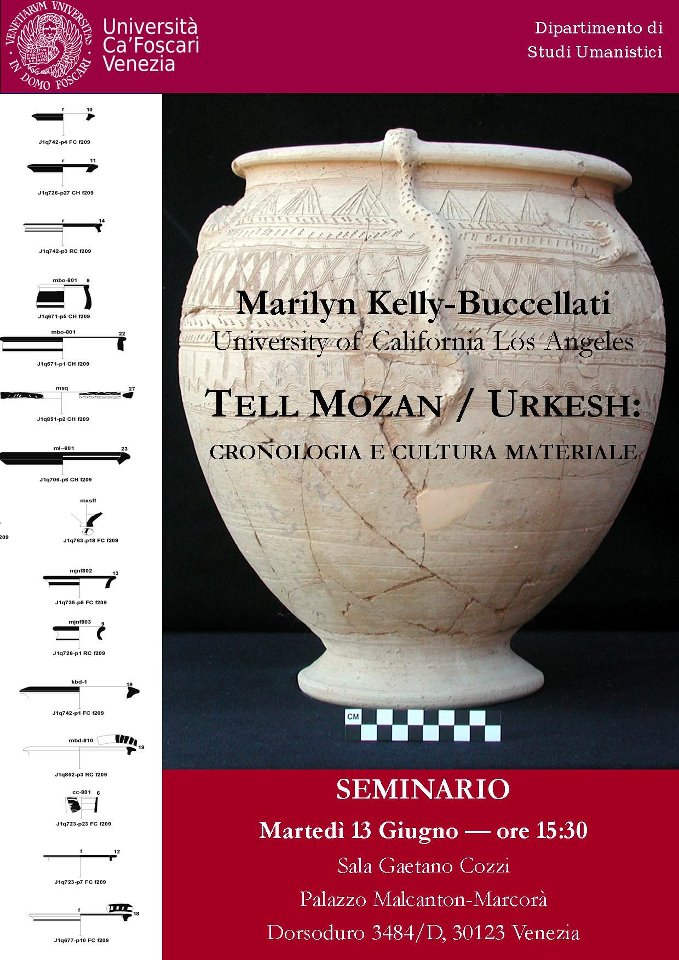
|
Marilyn Kelly-Buccellati
“Tell Mozan/Urkesh: cronologia e cultura materiale”
|
September 11-13 – Vinogradov Institute of the Russian Language, Russian Academy of Sciences, Moscow, Russia
|
|
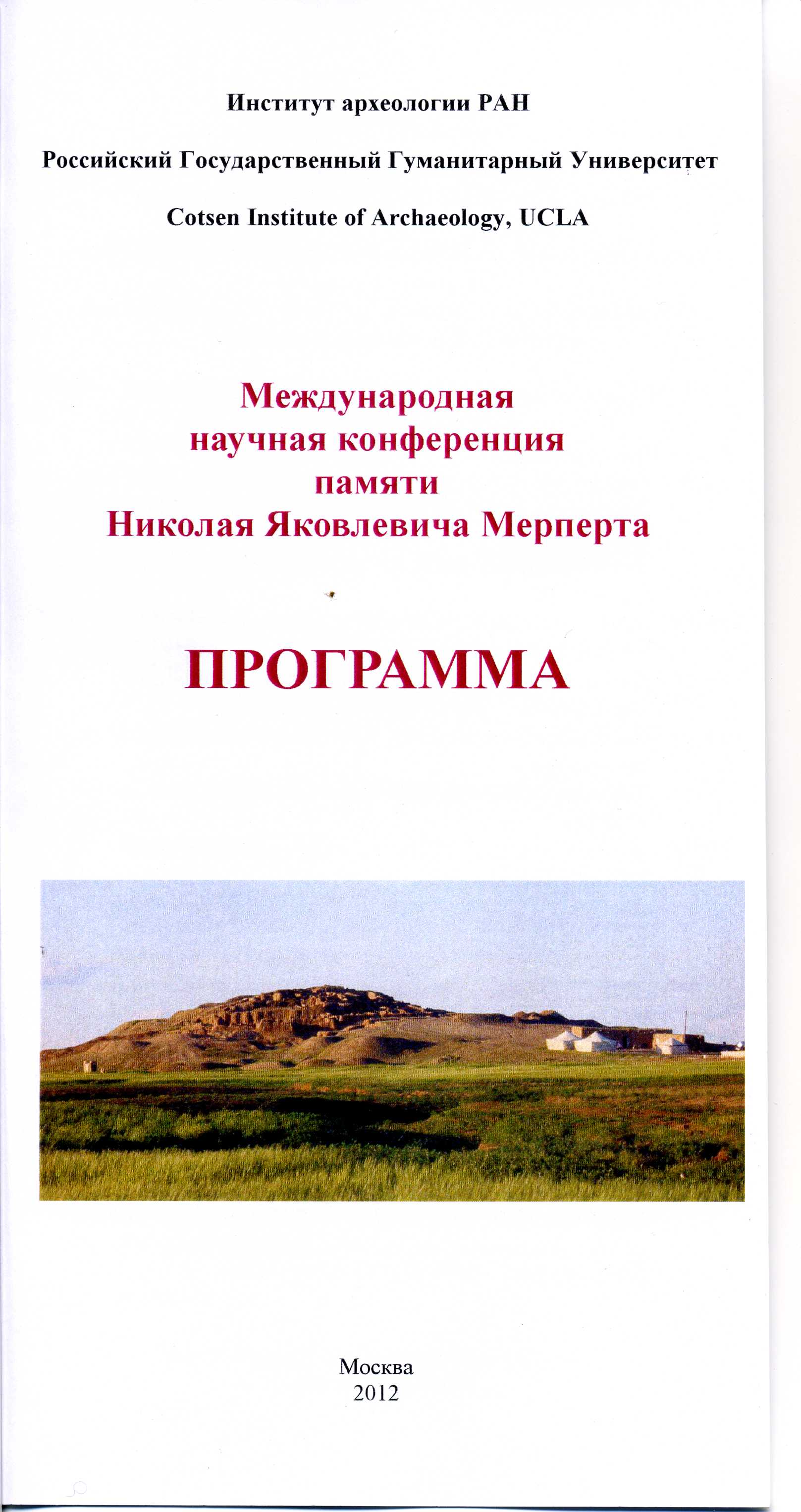 |
Giorgio Buccellati
“The Other Urban Revolution”
Abstract
“Towards a Linguistic Model for Archaeology”
PDF of the presentation available at this link.
Abstract
Marilyn Kelly-Buccellati
“The Late Prehistoric Levels at Urkesh”
Abstract
Federico A. Buccellati
“The Political Dimension of the Urkesh City-State?”
Abstract
“From 'Meaningful Action' to a 3D Model”
|
October 27-28 – Household and Household Economies in 3rd Millennium BC Syro-Mesopotamia Workshop, Frankfurt am Main, Germany
|
|
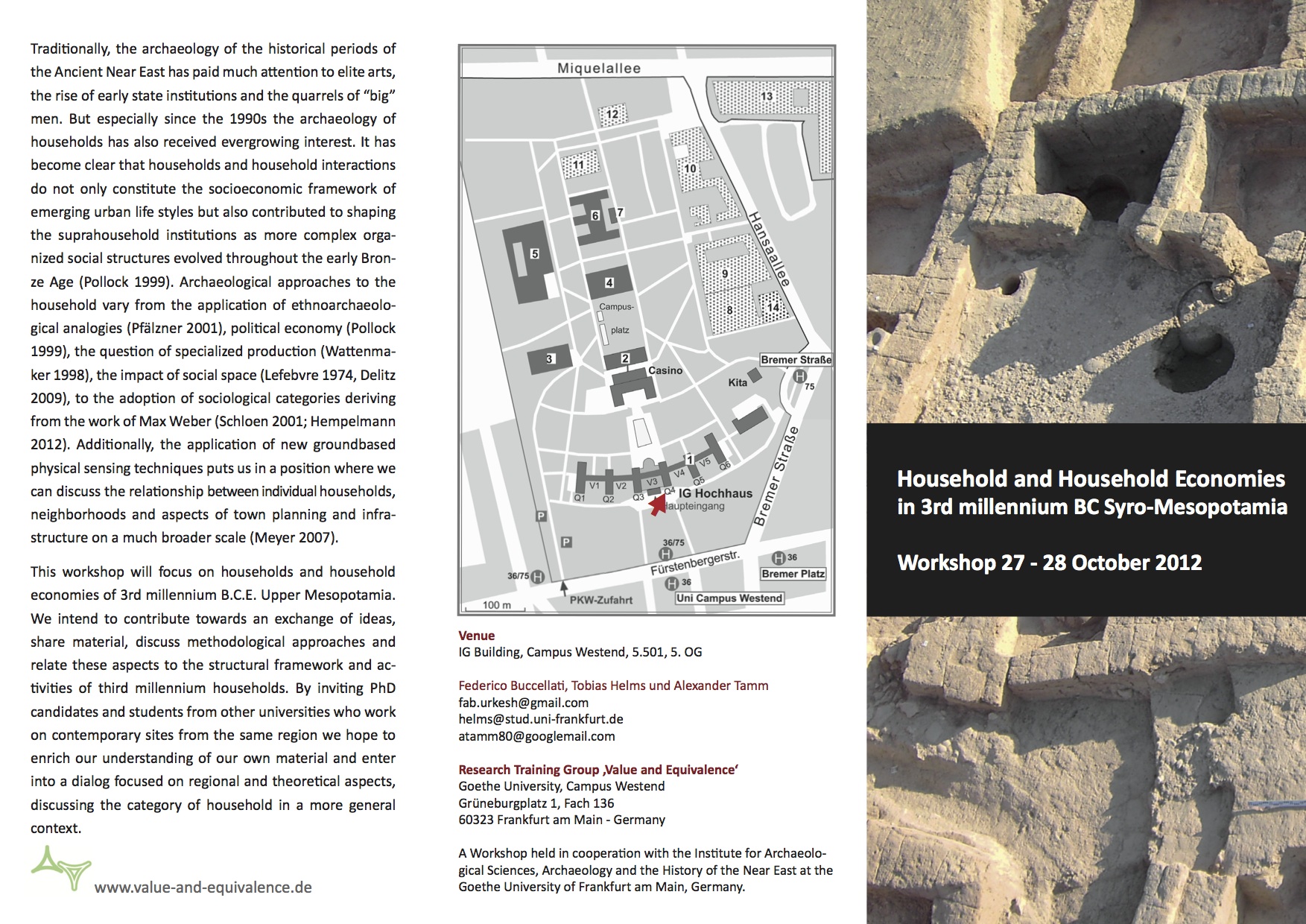 |
Federico A. Buccellati
“Understanding households: a few thoughts”
Caitlin J. Chaves Yates
“Households and neighborhoods in an urban environment: a case study using survey data from Tell Mozan, Syria”
|
November – American Society of Oriental Research Annual Meeting, Chicago, USA
|
|
|
Caitlin J. Chaves Yates
“Archaeology and the Development of an Eco-Archaeological Park at Tell Mozan, Syria”
|
November 16 – 'Schaffen Bilder Wissen?' Workshop, Frankfurt am Main, Germany
|
|
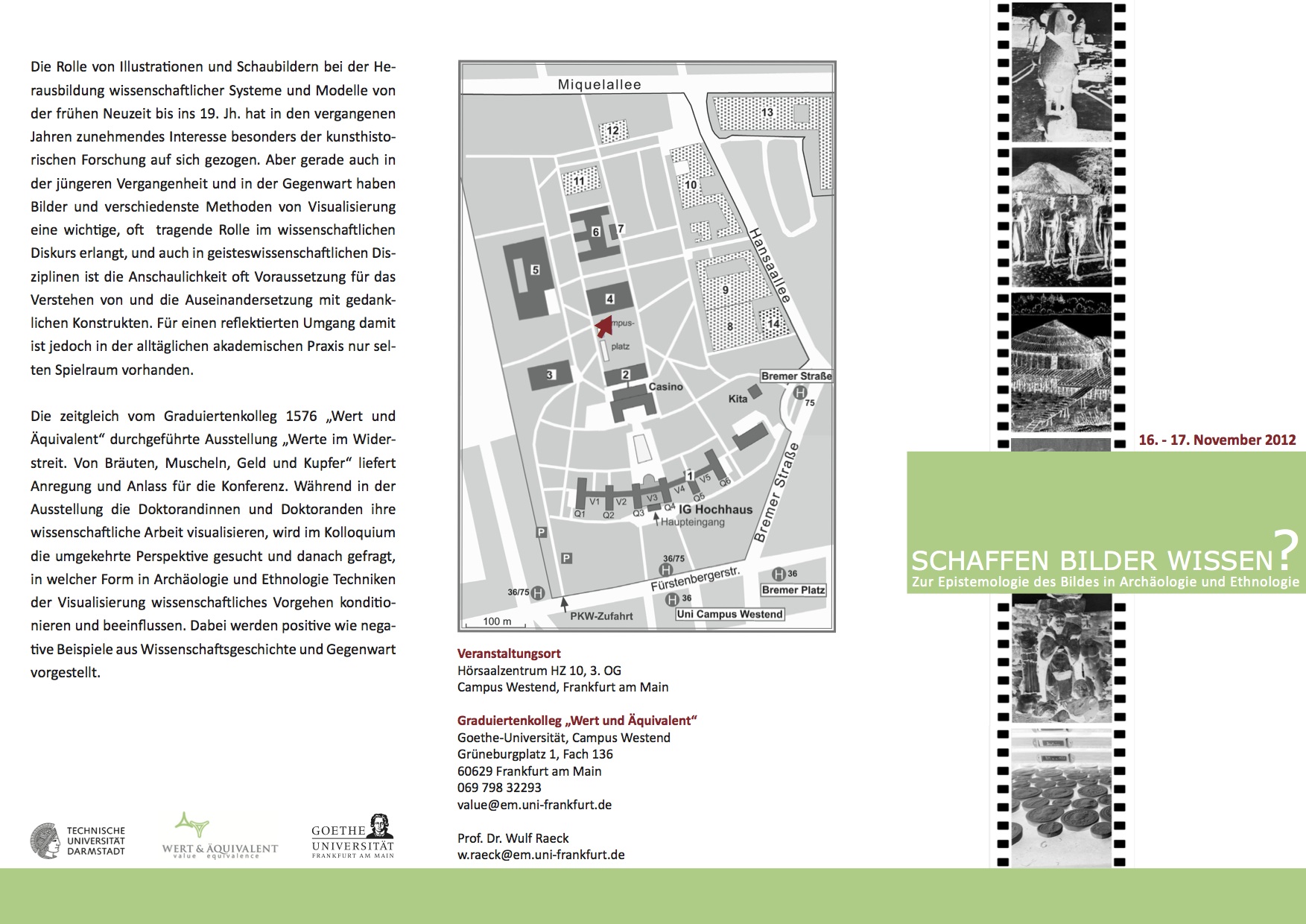 |
Federico A. Buccellati with P. Serba
“Making Architecture Portable: Comparing Two Approaches to 3D Modelling”
|
November 29-30 – Milan, Italy
|
|
|
Federico A. Buccellati
“Authenticity and Culture”
“Authenticity: The Impact of Traditions”
|
December 3 – Center for Ancient Mediterranean and Near Eastern Studies, Florence, Italy
|
|
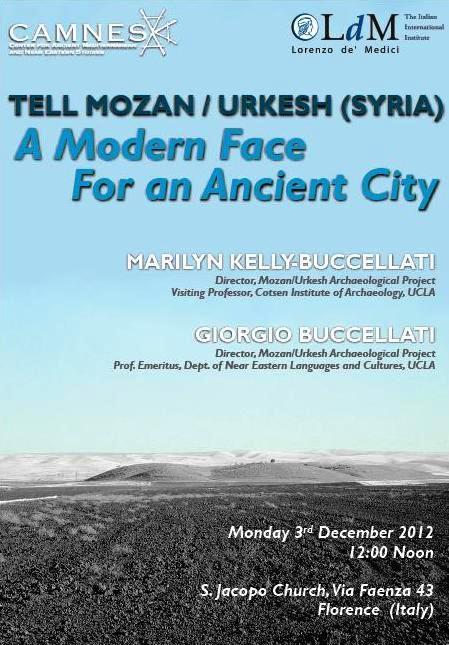
|
Marilyn Kelly-Buccellati and Giorgio Buccellati
“Tell Mozan/Urkesh (Syria): A Modern Face for an Ancient City”
Abstract
|
December 4 – Università degli Studi di Firenze, Florence, Italy
|
|
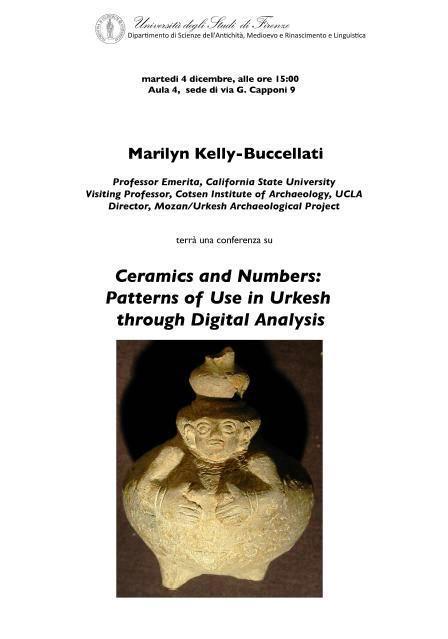
|
Marilyn Kelly-Buccellati
“Ceramics and Numbers: Patterns of Use in Urkesh through Digital Analysis”
Abstract
|
Back to top
2013
January 4 – Archaeological Institute of America Annual Meeting, Seattle, USA
|
|
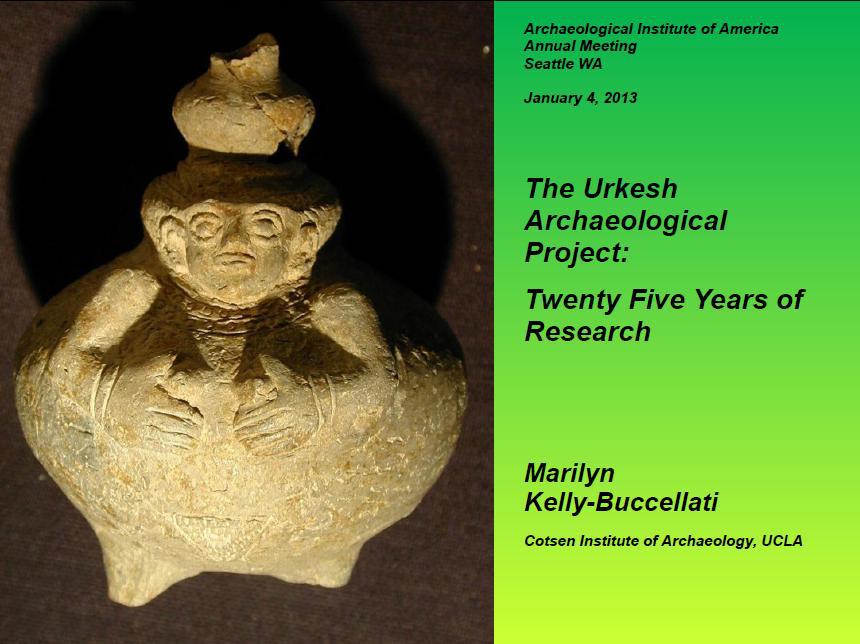
|
Marilyn Kelly-Buccellati
“The Urkesh Archaeological Project: Twenty Five Years of Research”
Abstract
|
January 17 – University of Mainz, Mainz, Germany
|
|
|
Federico A. Buccellati
“Architecture and Communication: The Palace of Tupkish at Urkesh”
|
January 31 – Freie Universität Berlin, Insitut für Vorderasiatische Archäologie, Berlin, Germany
|
|
|
Patrizia Camatta
“Hochtempel in Nordmesopotamien”
|
February 27 – UCLA, Los Angeles, USA
|
|
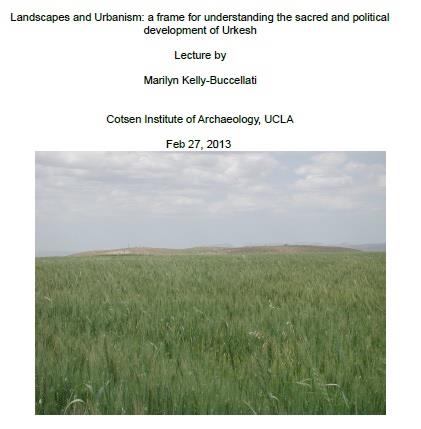
|
Marilyn Kelly-Buccellati
“Landscapes and Urbanism: a frame for understanding the sacred and political development of Urkesh”
Abstract
|
April 15 – Dialogue of Civilizations, Guatemala City, Guatemala
May 14 – Roma Tre Università, Rome, Italy
|
|
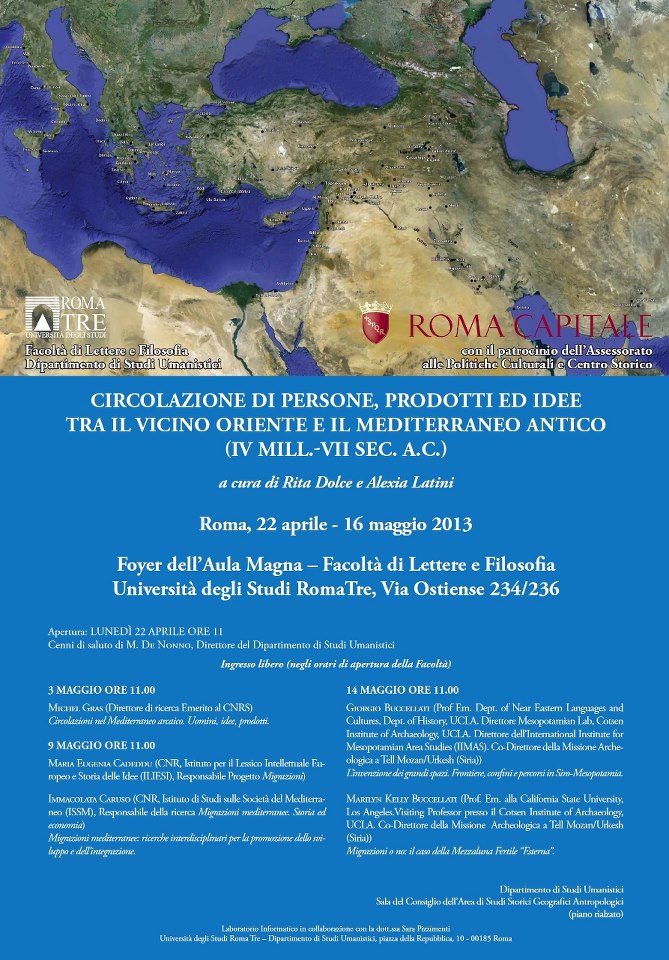
|
Giorgio Buccellati
“L'invenzione dei grandi spazi. Frontiere, confini e percorsi in Siro-Mesopotamia”
|
|
|

|
Marilyn Kelly-Buccellati
“Migrazioni o no: il caso della Mezzaluna Fertile 'Esterna'”
|
July 10 – Georgian National Museum, Georgia
|
|
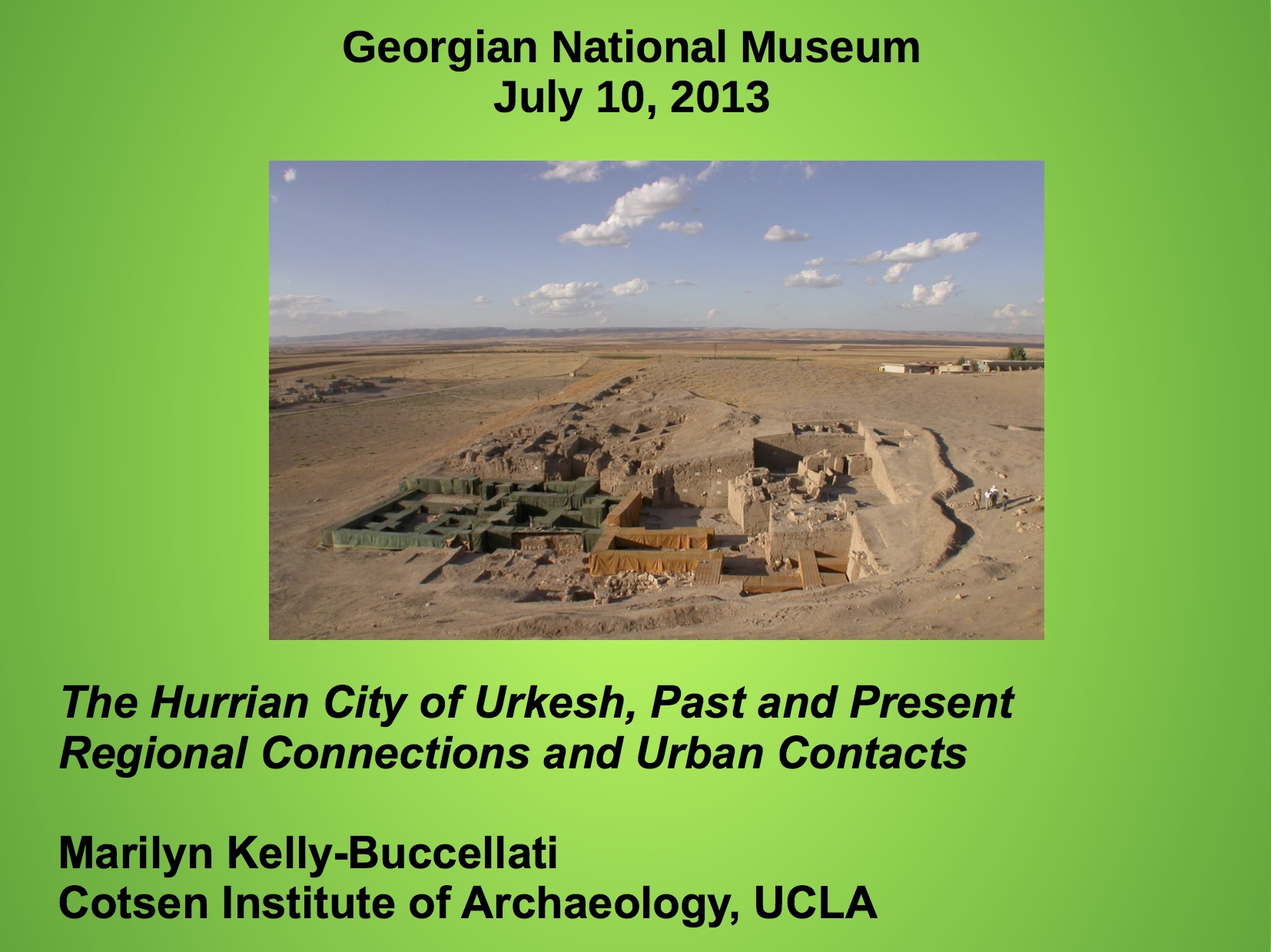
|
Marilyn Kelly-Buccellati
“The Hurrian City of Urkesh, Past and Present: Regional Connections and Urban Contacts”
|
July 22 – MESEURO, Rome, Italy
|
|
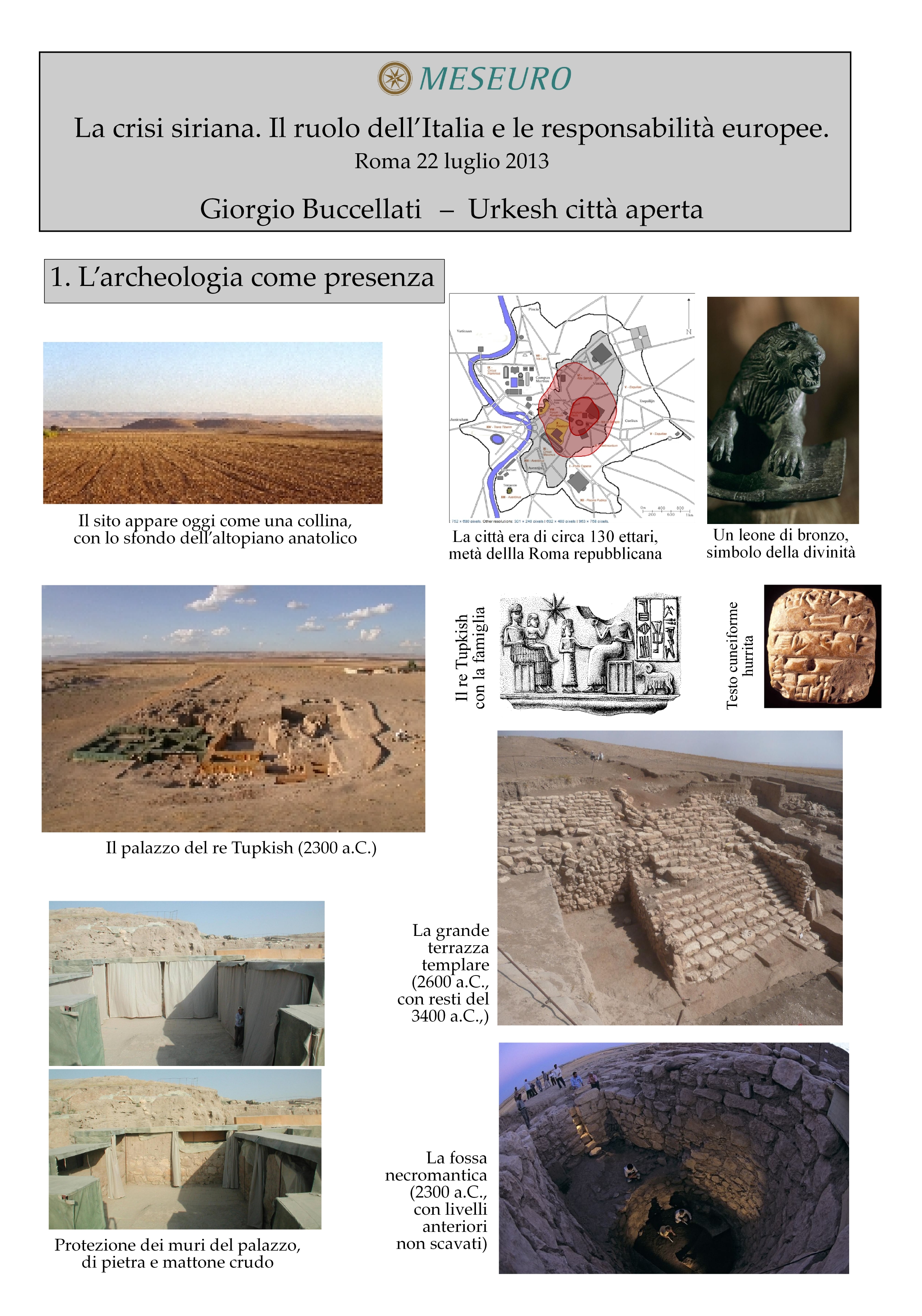
|
Giorgio Buccellati
“La crisi siriana: Il ruolo dell'Italia e le responsabilità europee”
|
August 20 – Meeting per l'Amicizia fra i Popoli, Rimini, Italy
|
|
|
Marilyn Kelly-Buccellati and Federico A. Buccellati
“La presenza di un passato remoto: la Mesopotamia nelle più recenti scoperte archeologiche”
Abstract
|
October 9 – Accademia dei Lincei, Italy
|
|
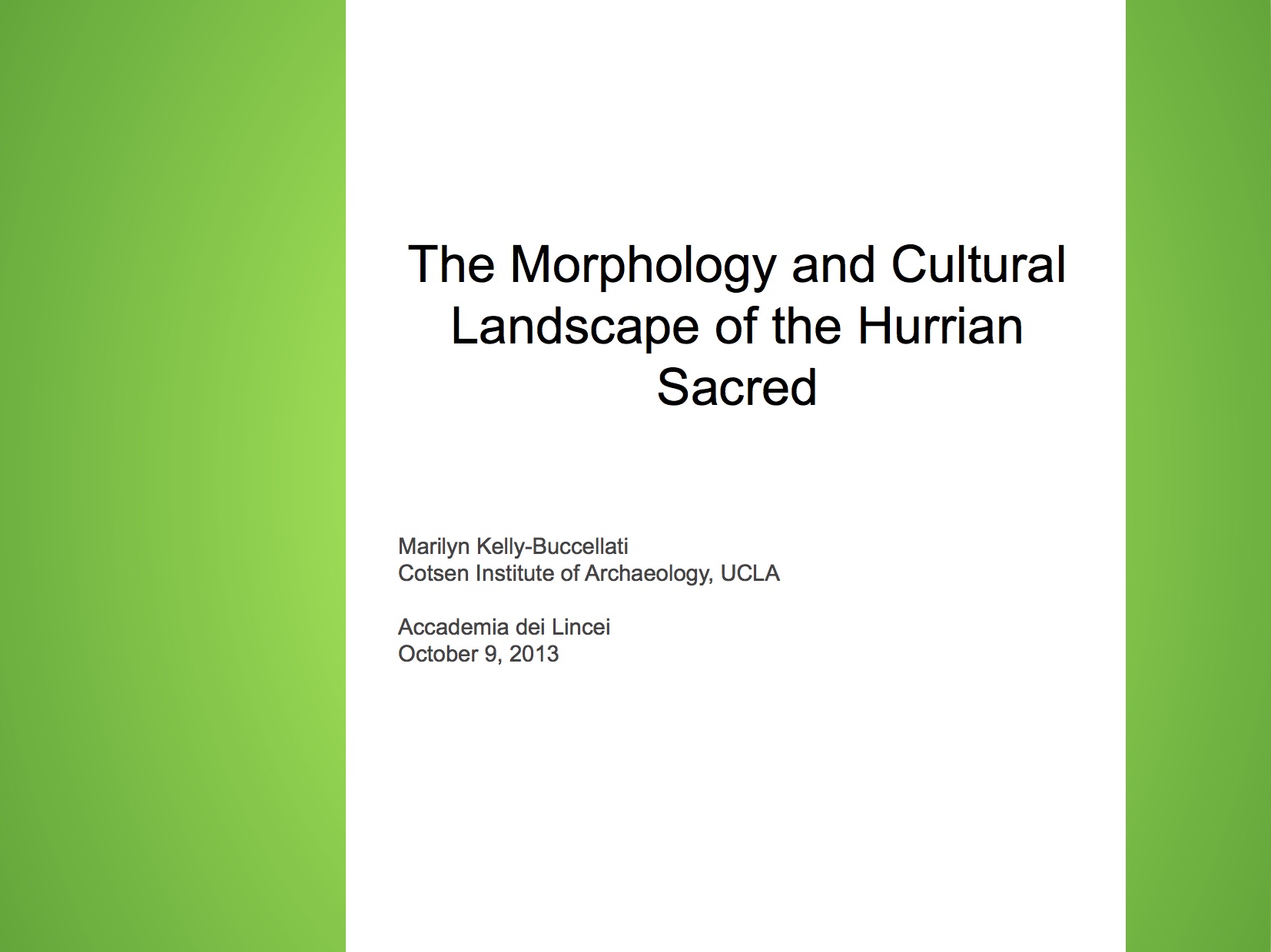
|
Marilyn Buccellati
“The Morphology and Cultural Landscape of the Hurrian Sacred”
|
October 14 – Sapienza Università di Roma, Rome, Italy
|
|
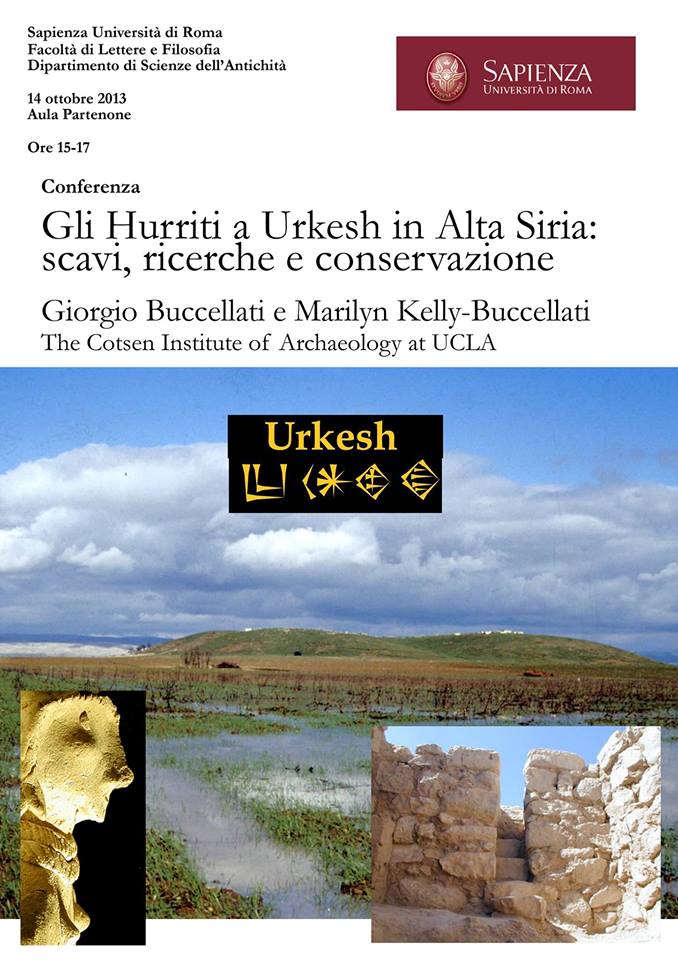
|
Giorgio Buccellati and Marilyn Kelly-Buccellati
“Gli Hurriti a Urkesh in Alta Siria: scavi, ricerche e conservazione”
|
November – American Society of Oriental Research Annual Meeting, USA
|
|
|
Caitlin J. Chaves Yates
“Urbanism in the Outer City: A Comparative Study of Early Bronze Age Outer Cities at Tell Mozan and Tell Chuera”
|
November 11 – Università Ca' Foscari, Venice, Italy
|
|
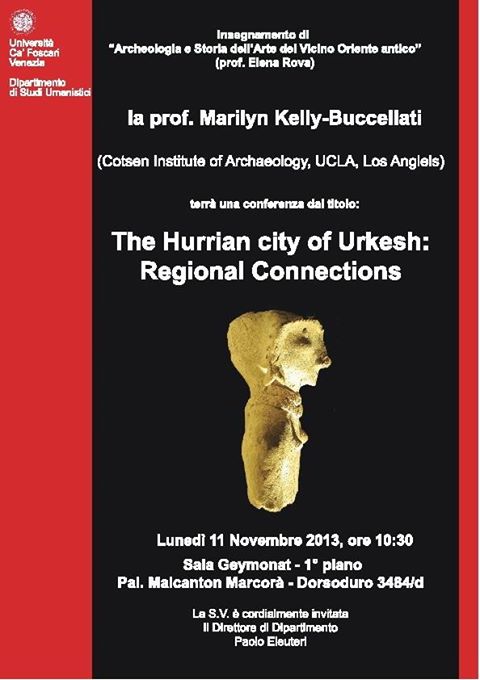
|
Marilyn Kelly-Buccellati
“The Hurrian City of Urkesh: Regional Connections”
Abstract
|
November 19 – Cercle Genevois d'Archéologie, Geneva, Switzerland
|
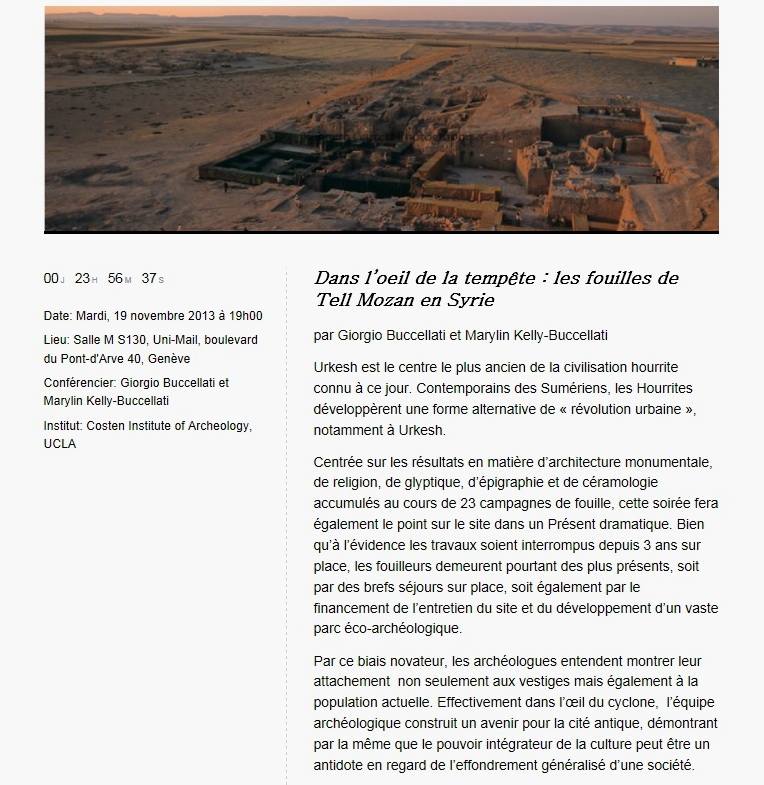
|
Giorgio Buccellati and Marilyn Kelly-Buccellati
“Dans l'œil de la tempête: les fouilles de Tell Mozan en Syrie”
|
December 20 – Séminaire VEPMO, ArScan, CNRS, Paris, France
|
|
Federico A. Buccellati
“Three dimensional Volumetric Analysis in an Archaeological Context : the palace of Tupkish at Urkesh and its representation”
|
December 16 – Sapienza Università di Roma, Rome, Italy
|
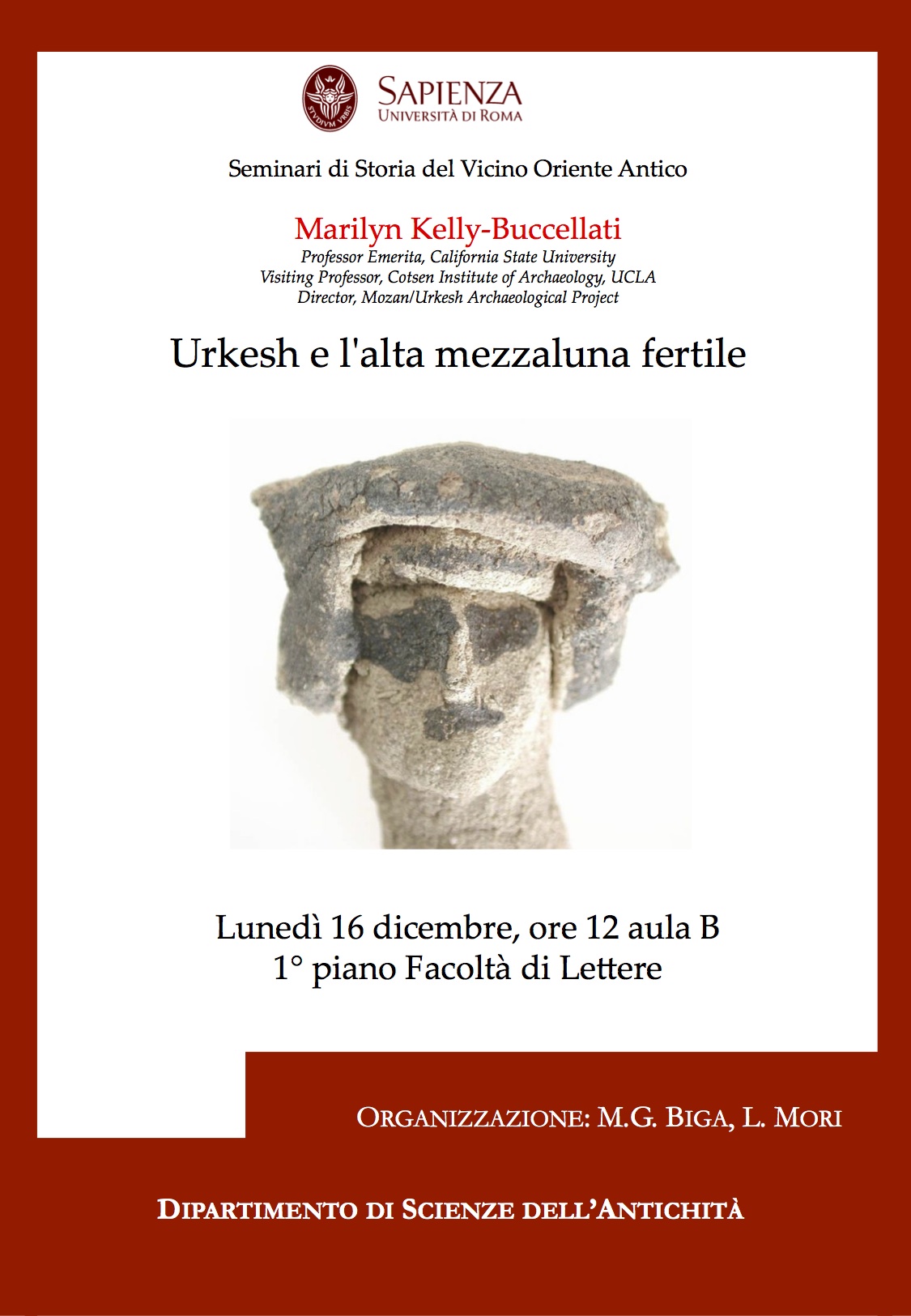
|
Marilyn Kelly-Buccellati
”Urkesh e l'alta mezzaluna fertile”
|
Back to top
2014
May 19 – AUR
|
|
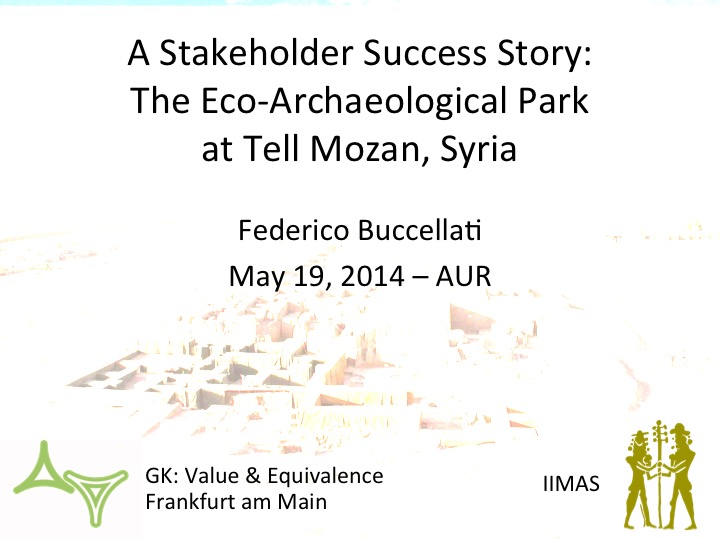
|
Federico A. Buccellati
“A Stakeholder Success Story: The Eco-Archaeological Park at Tell Mozan, Syria”
|
June 23 – Institut Français à Erbil, Iraq
|
|
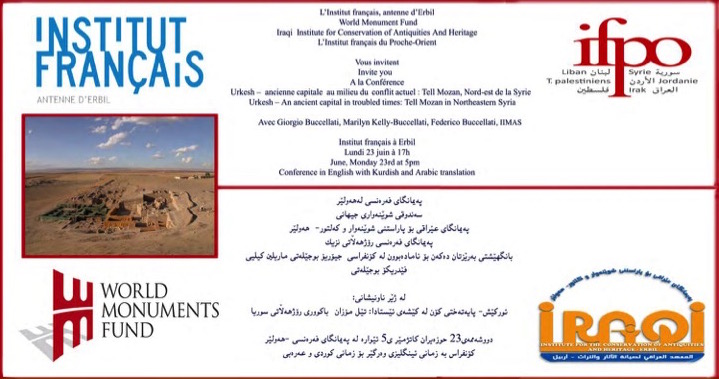
|
Giorgio Buccellati, Marilyn Kelly-Buccellati, Federico A. Buccellati
“Urkesh entre 3500 - 1300 av. J.C. / Tell Mozan, Syrie, 2011-2014 apr. J.C.”
|
July – Peripherie Wirtschaftszonen in Siedlungen Workshop, Bonn, Germany
|
|
|
Caitlin J. Chaves Yates
“Distributed Urbanism: Variety and Complexity of Activities in Syrian Third-Millennium Outer Cities”
|
August 24 – Meeting per l'Amicizia fra i Popoli, Rimini, Italy
|
|
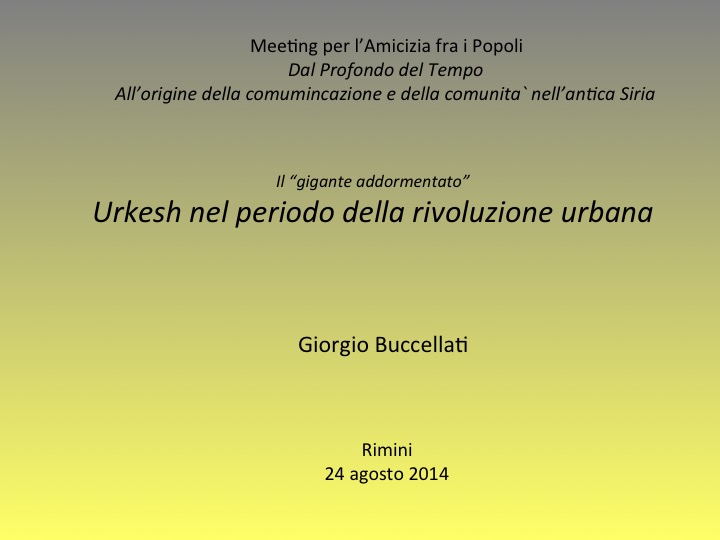
|
Giorgio Buccellati
“Il 'gigante addormentato': Urkesh nel periodo della rivoluzione urbana”
|
October 7 – Rassegna Internazionale del Cinema Archeologico, Rovereto, Italy
|
|
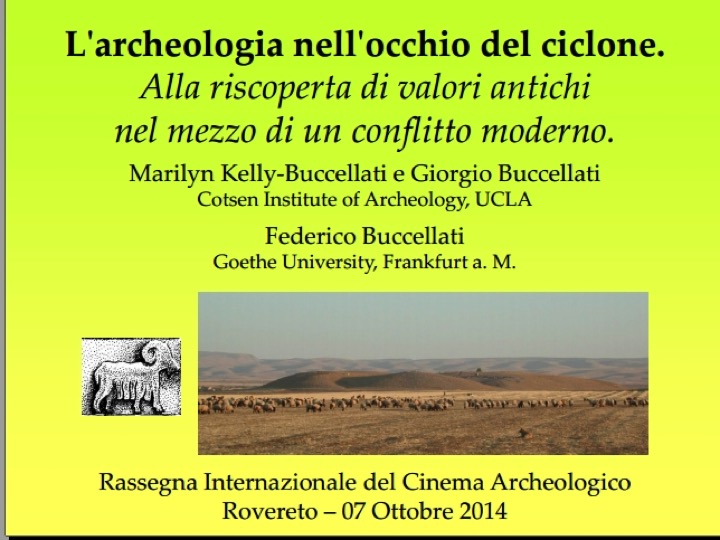
|
Marilyn Kelly-Buccellati, Giorgio Buccellati, Federico A. Buccellati
“L'archeologia nell'occhio del ciclone: Alla riscoperta di valori antichi nel mezzo di un conflitto moderno”
|
October 30 – Licei Classico, Scientifico, Artistico Fondazione Sacro Cuore, Milan, Italy
|
|
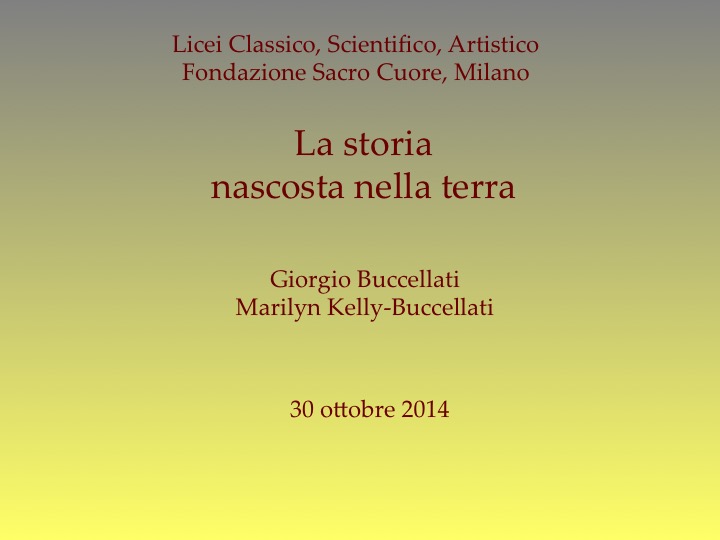
|
Giorgio Buccellati and Marilyn Kelly-Buccellati
“La storia nascosta nella terra”
Video of lecture
|
November 4 – Liceo 'Rosmini', Teatro Galletti, Domodossola, Italy
|
|
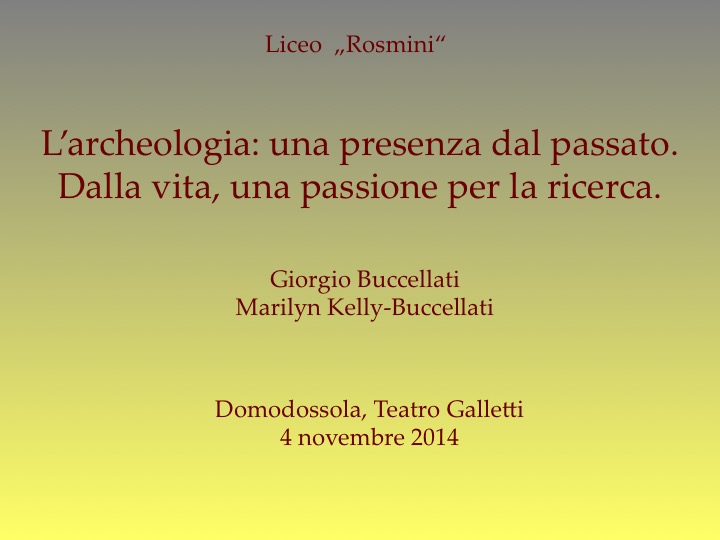
|
Giorgio Buccellati and Marilyn Kelly-Buccellati
“La storia nascosta nella terra”
|
Back to top
2015
February 27 – School of Theology and Religious Studies, Catholic University of America, USA
|
|
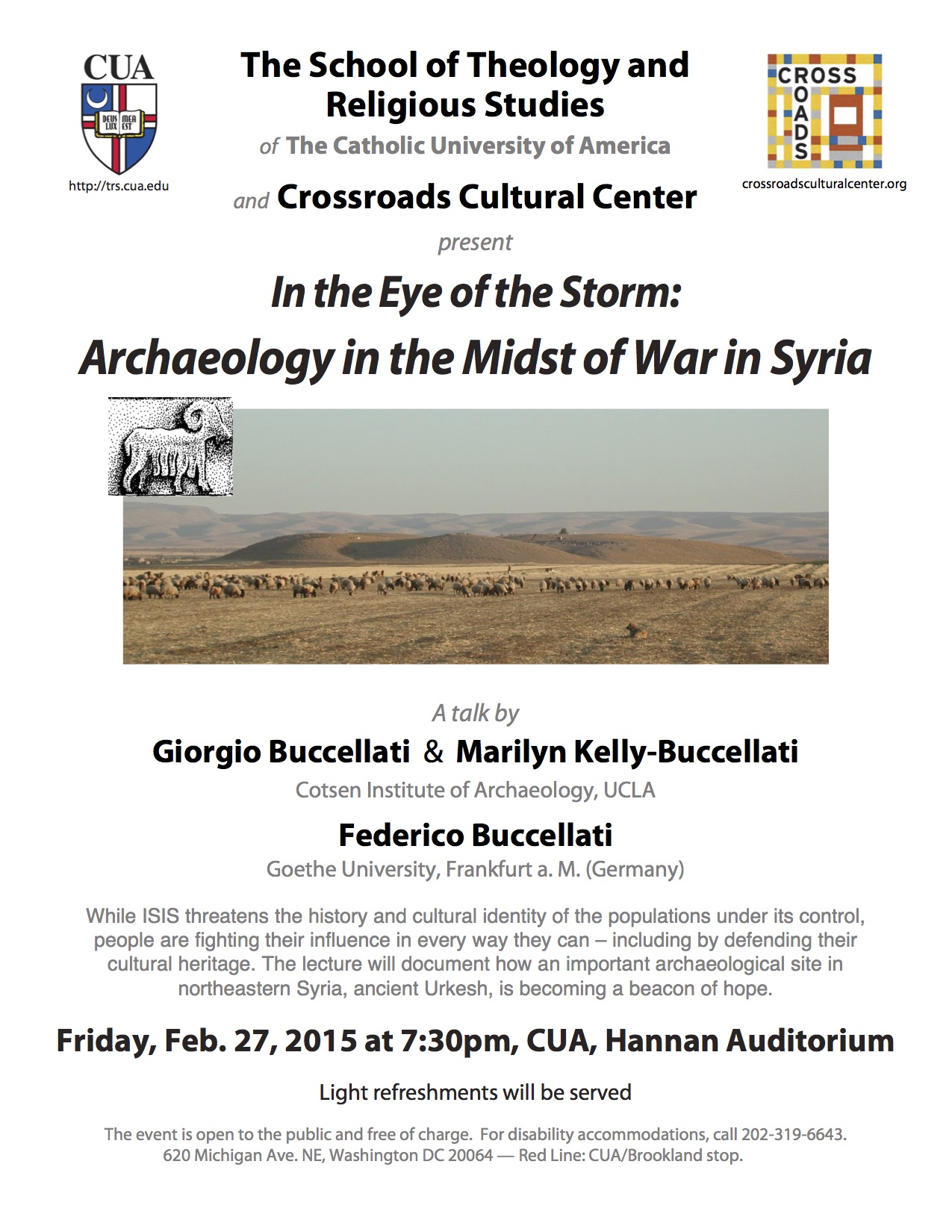
|
Giorgio Buccellati and Marilyn Kelly-Buccellati, Federico A. Buccellati
“In the Eye of the Storm: Archaeology in the Midst of War in Syria”
|
April 28 – Berliner Antike Kolleg and Vorderasiatische Institut der Freien Universität Berlin, Germany
|
|
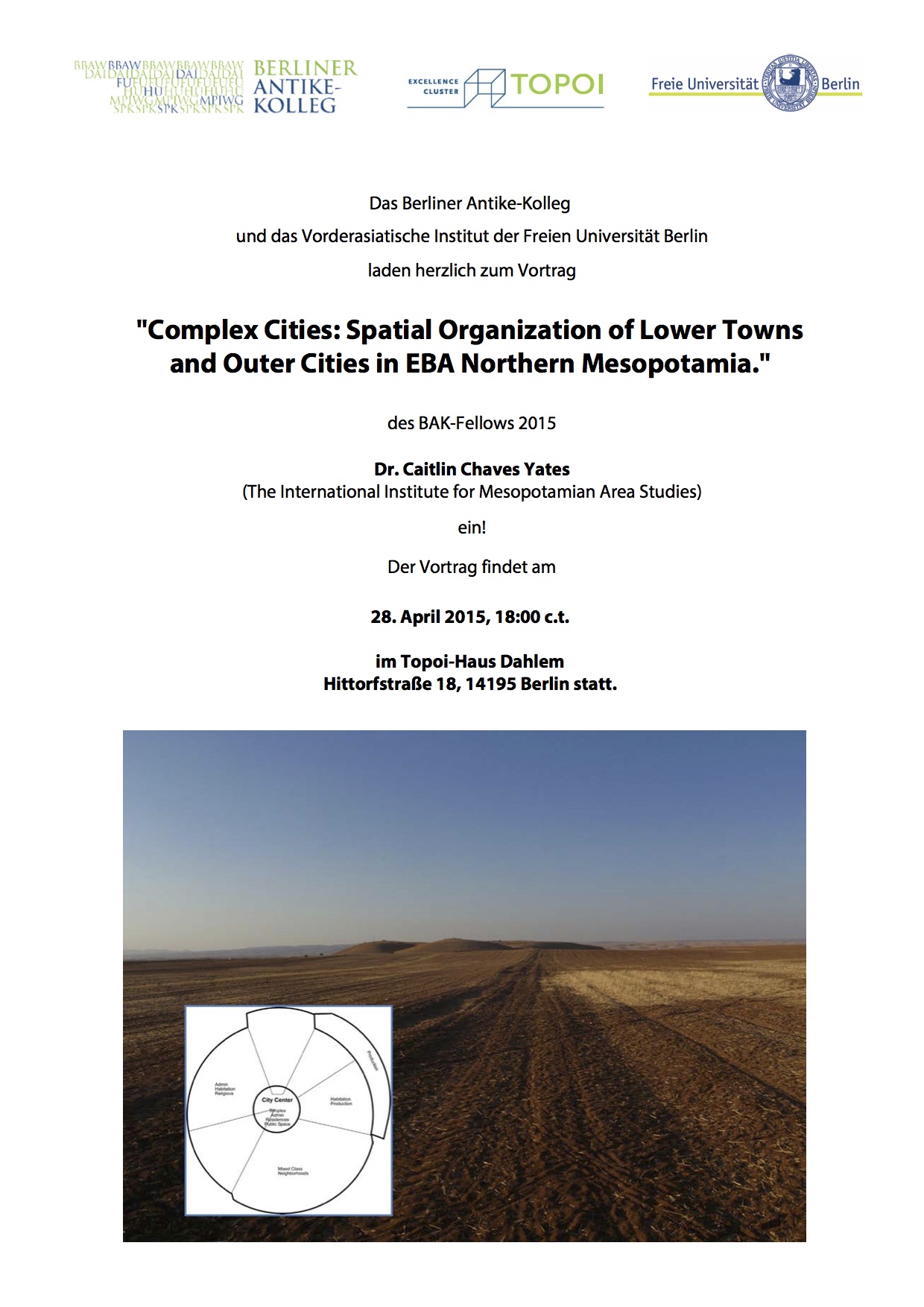
|
Caitlin J. Chaves Yates
“Complex Cities: Spatial Organization of Lower Towns and Outer Cities in EBA Northern Mesopotamia”
|
November 30 - SIRIA, patrimonio archeologico e artistico: passato, presente ... futuro?, University of Pavia, Italy
|
|
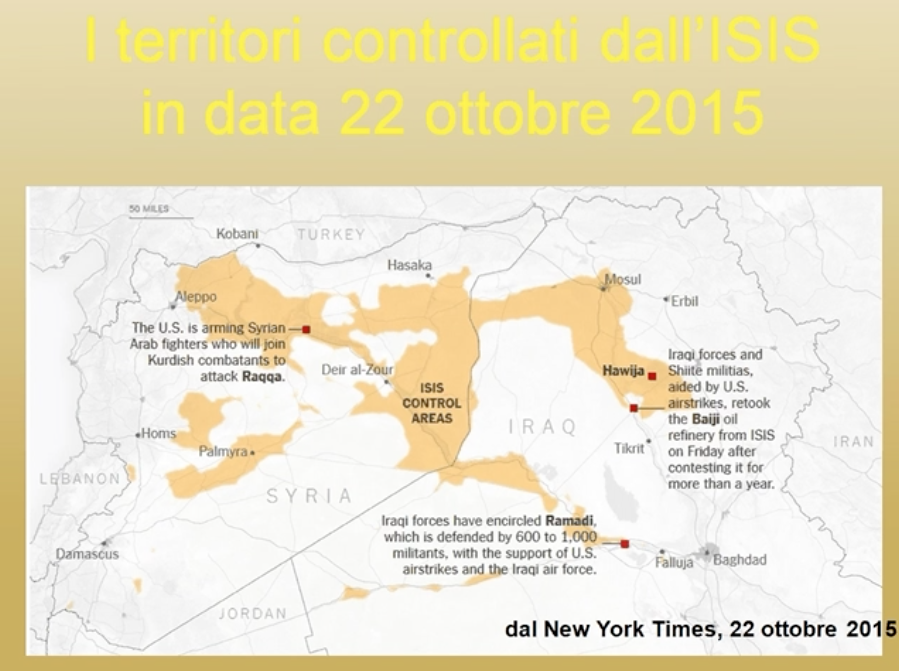
|
Giorgio Buccellati and Marilyn Kelly-Buccellati
“Past, Present, Future”
|
December 3 – International Syrian Congress on Archaeology and Cultural Heritage, Beirut, Lebanon
|
|
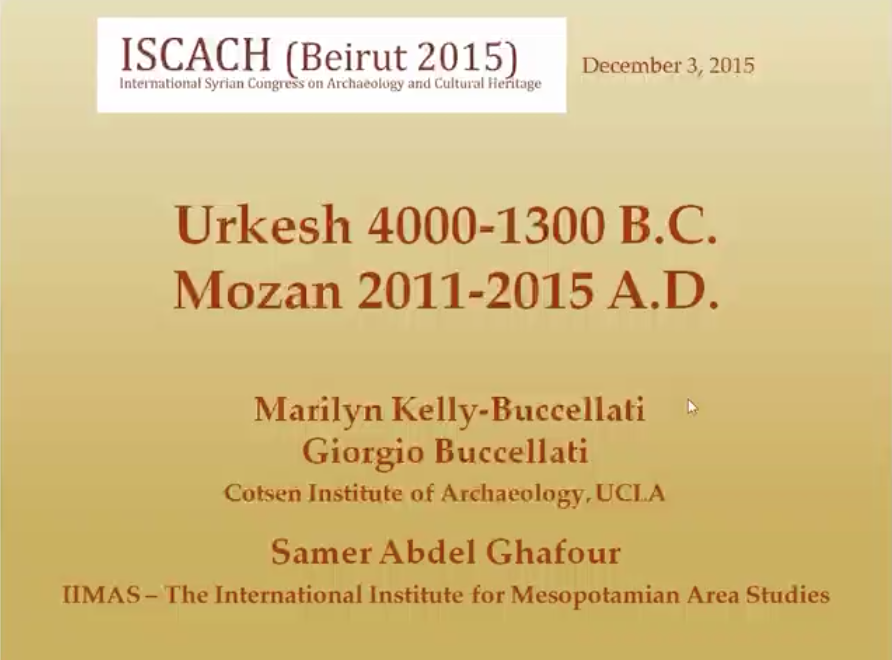
|
Giorgio Buccellati, Marilyn Kelly-Buccellati, Samer Abdel Ghafour
“Urkesh 4000-1300 B.C., Mozan 2011-2015 A.D.”
|
December 18 – Fondazione Faraggiana, Novara, Italy
|
|
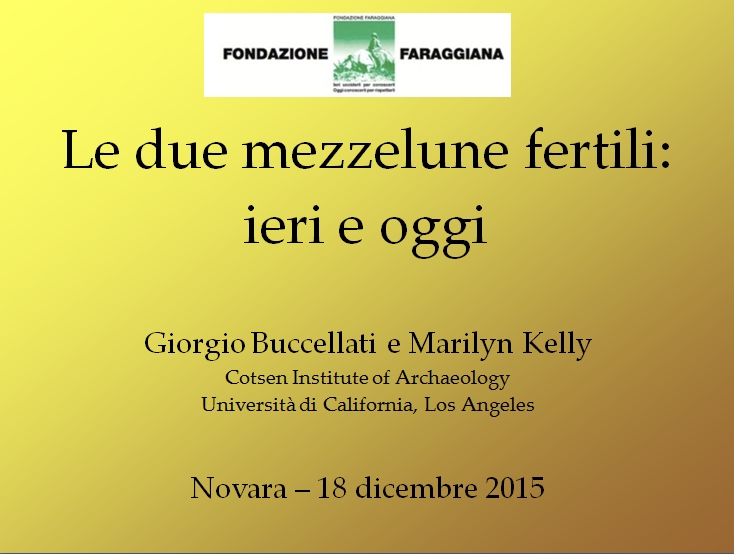
|
Giorgio Buccellati, Marilyn Kelly-Buccellati, Samer Abdel Ghafour
“Le due mezzelune fertili: ieri e oggi”
|
Back to top
2016
January 27 – Cotsen Institute of Archaeology, USA
|
|
|
Giorgio Buccellati
“In the Eye of the Storm: The Resilience of the Urkesh Project in the Midst of the Syrian War”
|
June 14 – Centro Culturale di Firenze, Italy
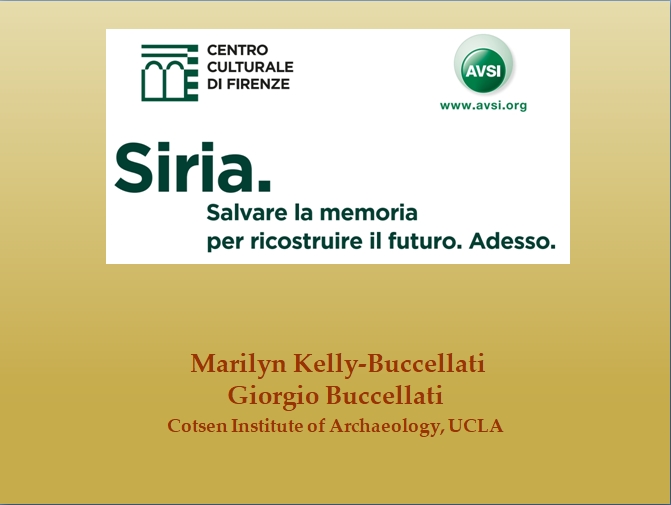
|
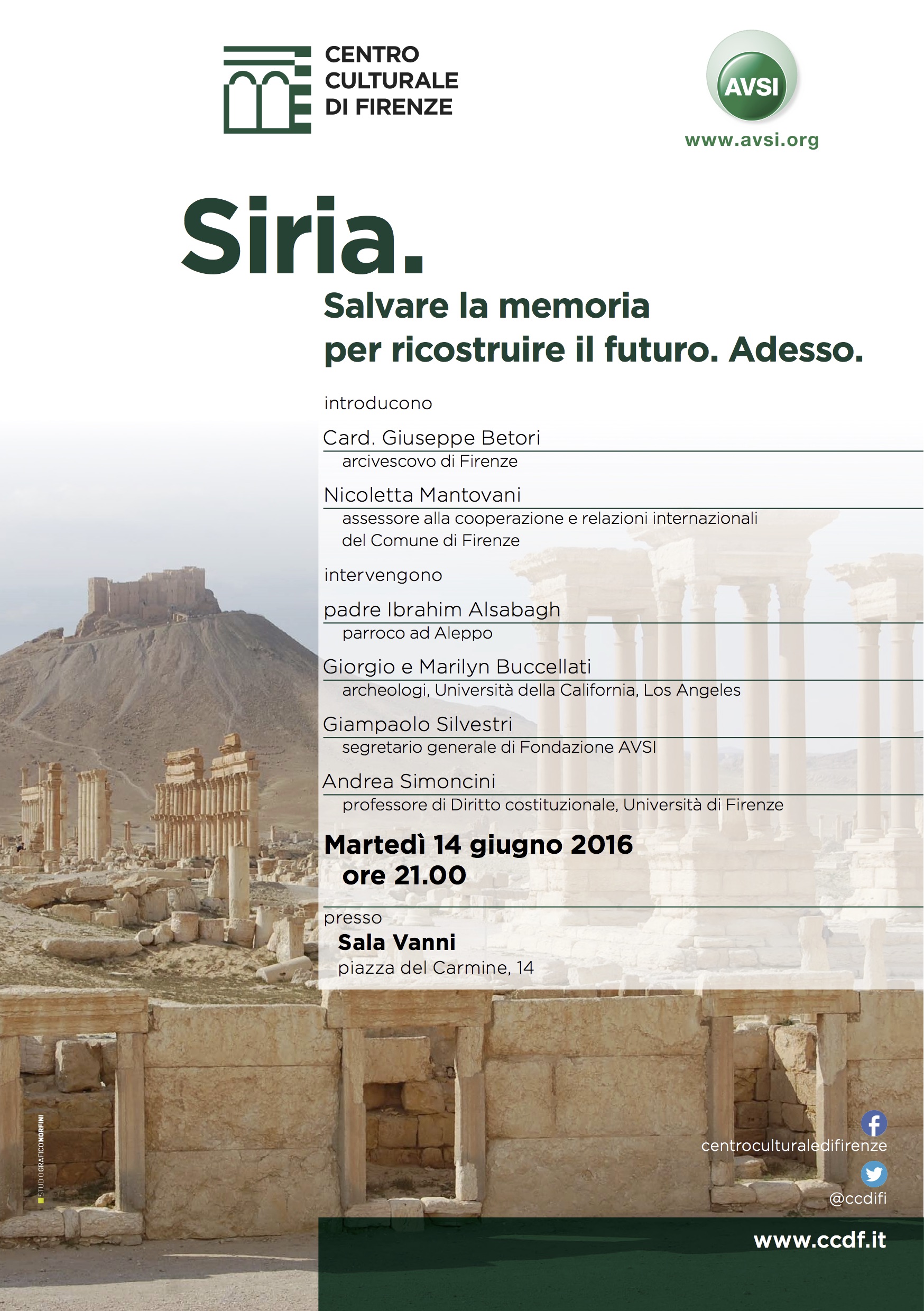
|
Marilyn Kelly-Buccellati and Giorgio Buccellati
“Siria. Salvare la memoria per ricostruire il futuro. Adesso”
|
June 25 – Association for Research into Crimes Against Art
|
|
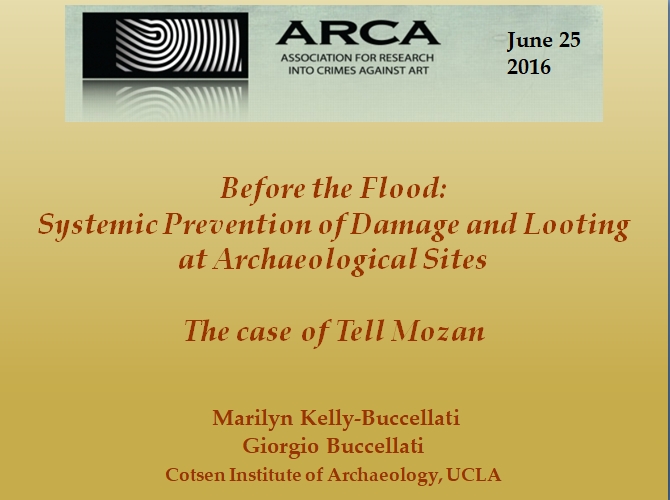
|
Marilyn Kelly-Buccellati and Giorgio Buccellati
“Before the Flood: Systemic Prevention of Damage and Looting at Archaeological Sites. The Case of Tell Mozan”
|
October 31 – Mele Miele, Baceno, Italy
|
|
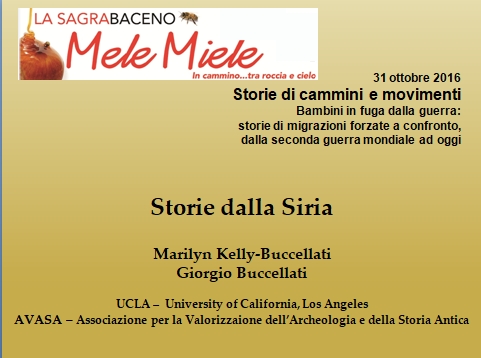
|
Marilyn Kelly-Buccellati and Giorgio Buccellati
“Storie dalla Siria”
|
November 9 – Associazione Archeologica Ticinese, Italy
|
|
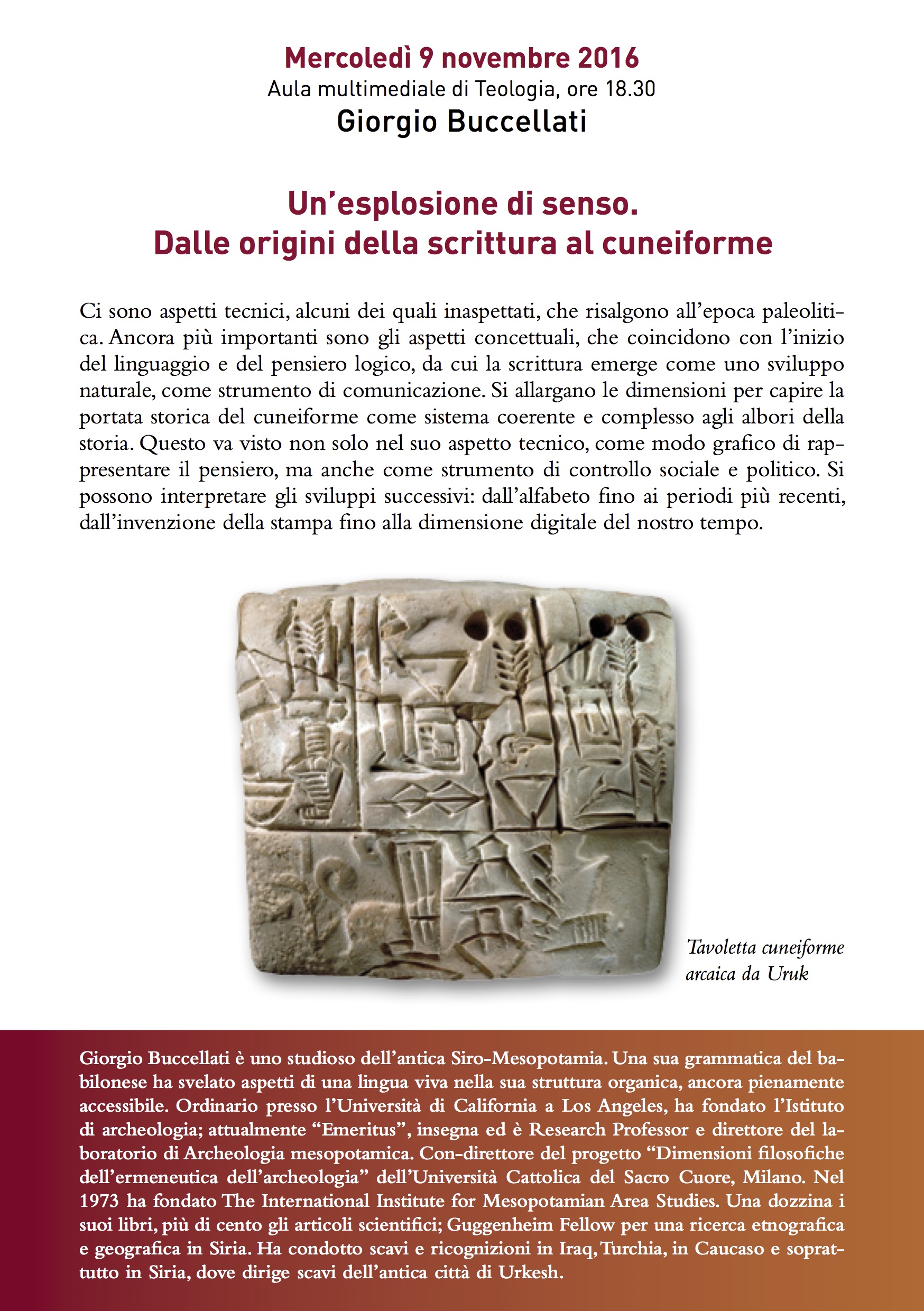
|
Giorgio Buccellati
“Un'esplosione di senso. Dalle origini della scrittura al cuneiforme”
|
November 15 – Museo Egizio, Torino, Italy
|
|
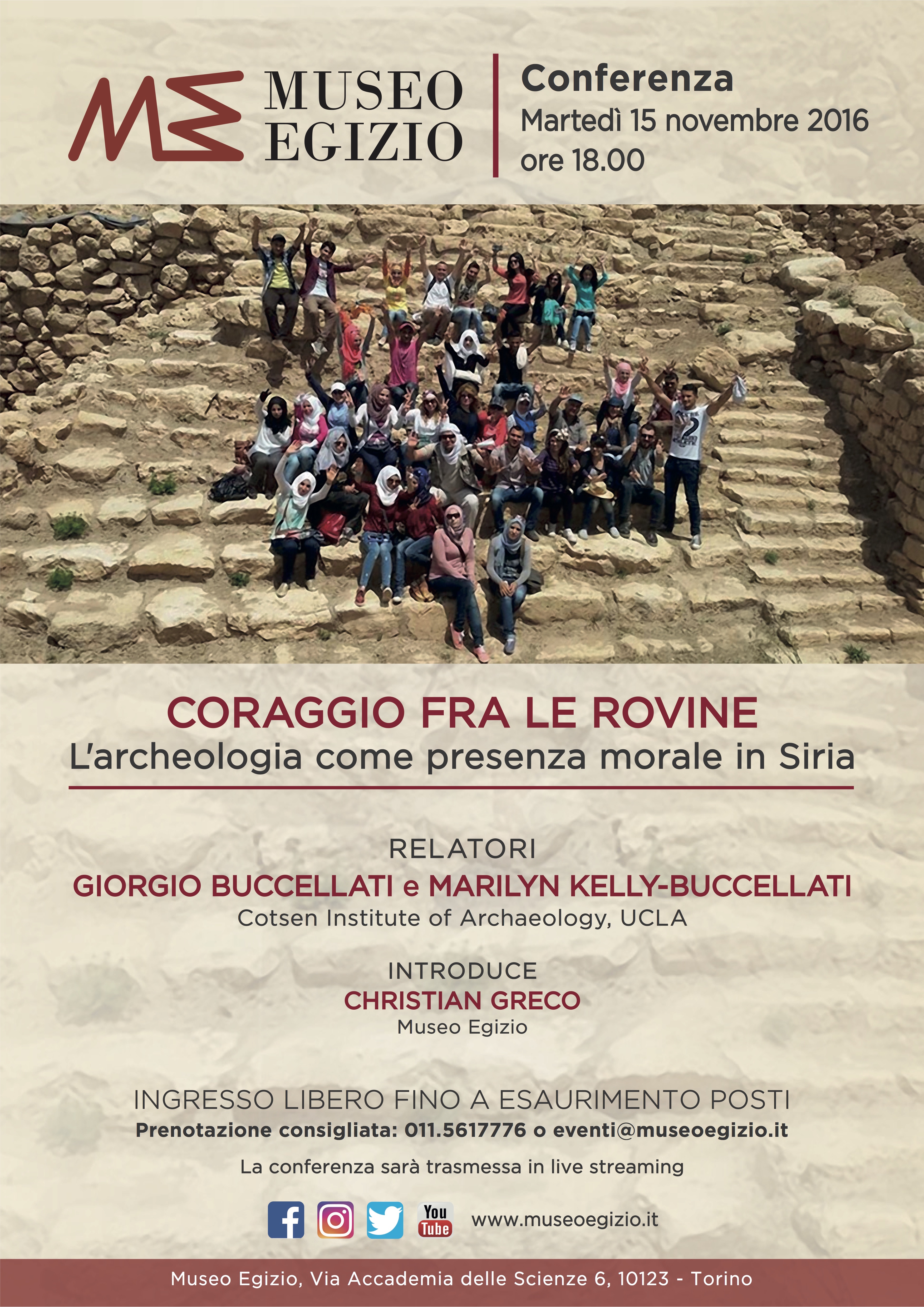
|
Giorgio Buccellati and Marilyn Kelly-Buccellati
“Coraggio fra le rovine. L'archeologia come presenza morale in Siria”
|
December 10 – New Visions and Proposals for the Resiience of the Syrian Heritage, Damascus, Syria
|
|
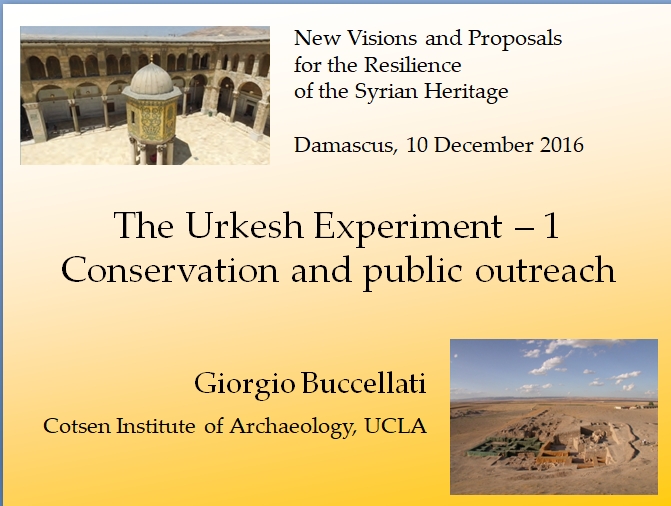
|
Giorgio Buccellati
“The Urkesh Experiment – 1. Conservation and public outreach”
|
December 16 – CAMNES, Firenze, Italy
|
|
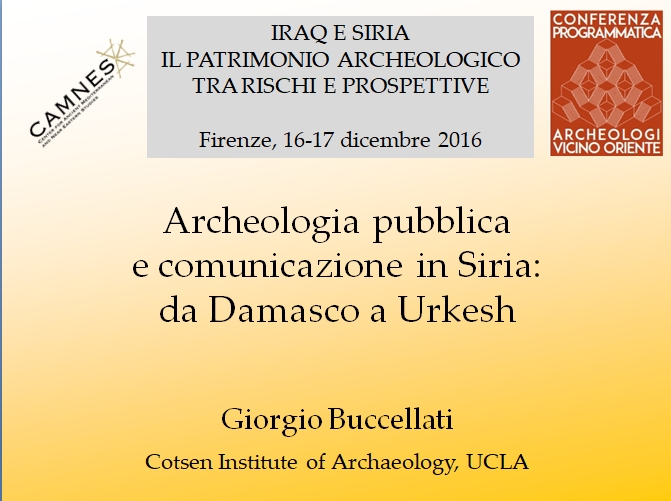
|
Giorgio Buccellati
“Archeologia pubblica e comunicazione in Siria: da Damasco a Urkesh”
|
December 17 – CAMNES, Firenze, Italy
|
|
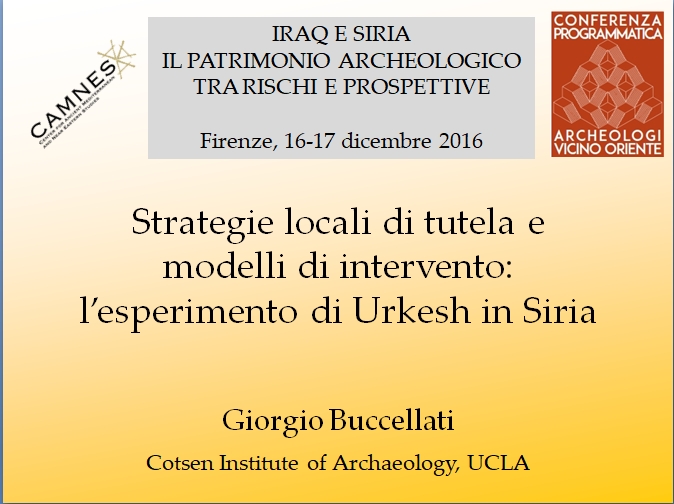
|
Giorgio Buccellati
“Strategie locali di tutela e modelli di intervento: l'esperimento di Urkesh in Siria”
|
Back to top
2017
January 14 – AVASA, Beola, Italy
|
|
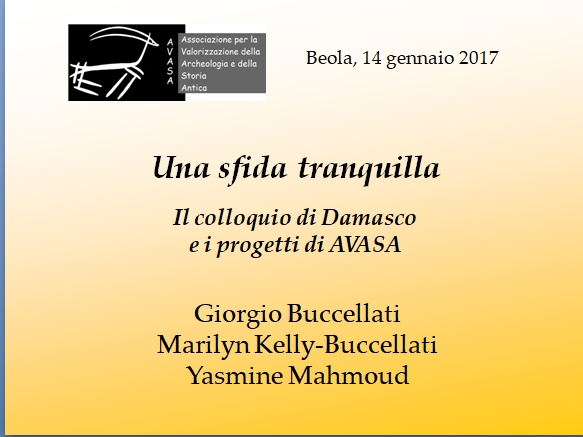
|
Giorgio Buccellati, Marilyn Kelly-Buccellati, Yasmine Mahmoud
“Una sfida tranquilla: Il colloquio di Damasco e i progetti di AVASA”
|
February 8 – The Getty Research Institute, Los Angeles, USA
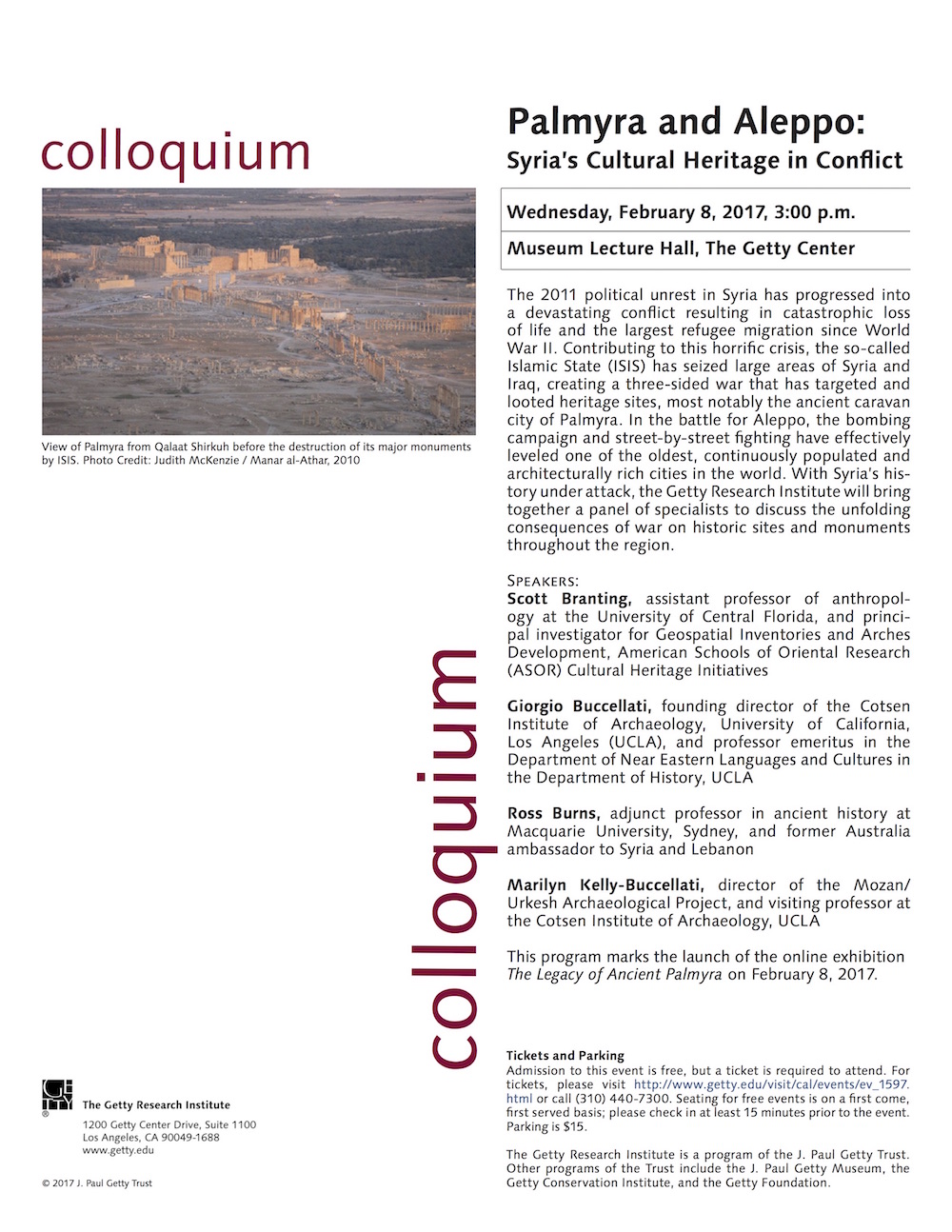
|
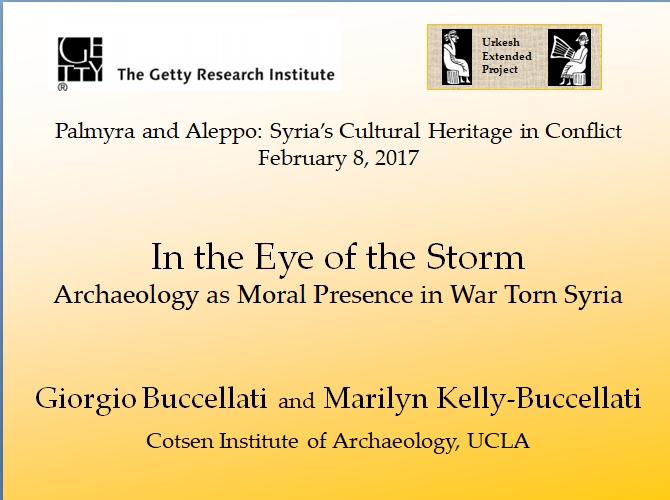
|
Giorgio Buccellati and Marilyn Kelly-Buccellati
“In the Eye of the Storm: Archaeology as Moral Presence in War Torn Syria”
Video of lecture
|
April 1 – The PLATO Society of Los Angeles, USA
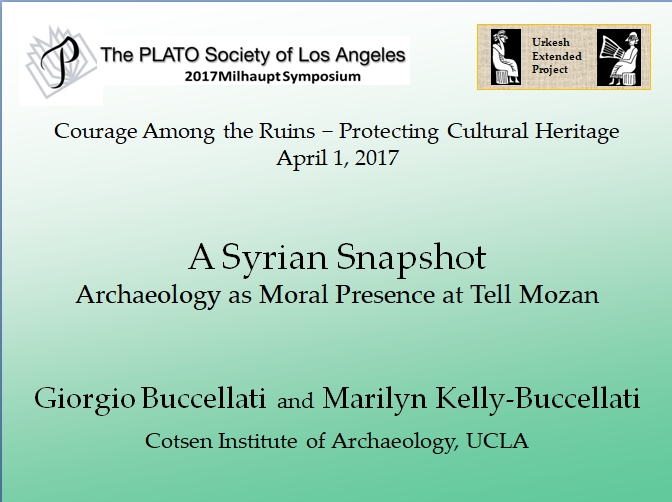
|

|
Giorgio Buccellati and Marilyn Kelly-Buccellati
“A Syrian Snapshot: Archaeology as Moral Presence at Tell Mozan”
|
April 12 – Cotsen Institute of Archaeology, Los Angeles, USA
|
|
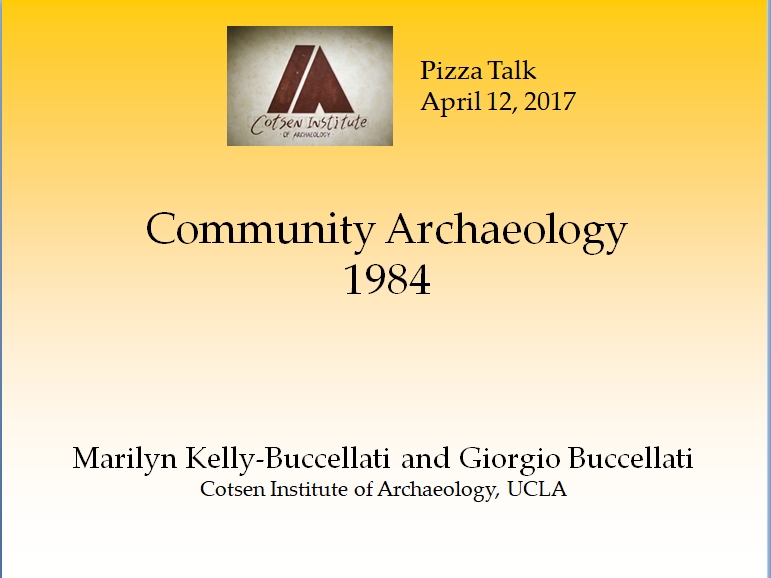
|
Marilyn Kelly-Buccellati and Giorgio Buccellati
“Community Archaeology 1984”
Video of lecture
|
April 20 – Houston Museum of Natural Science, USA
|
|
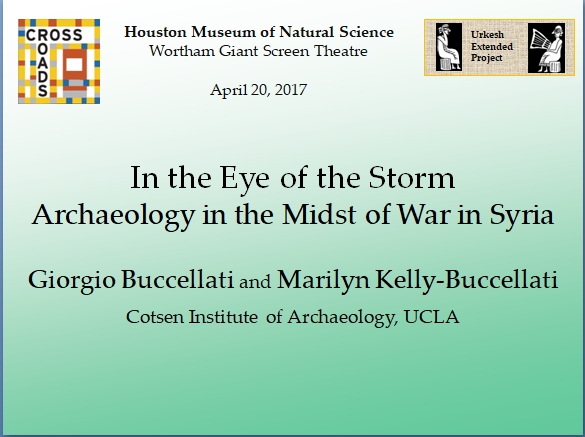
|
Giorgio Buccellati and Marilyn Kelly-Buccellati
“In the Eye of the Storm: Archaeology in the Midst of War in Syria”
|
October 30 – Scuola Media Statale di Domodossola
|
|
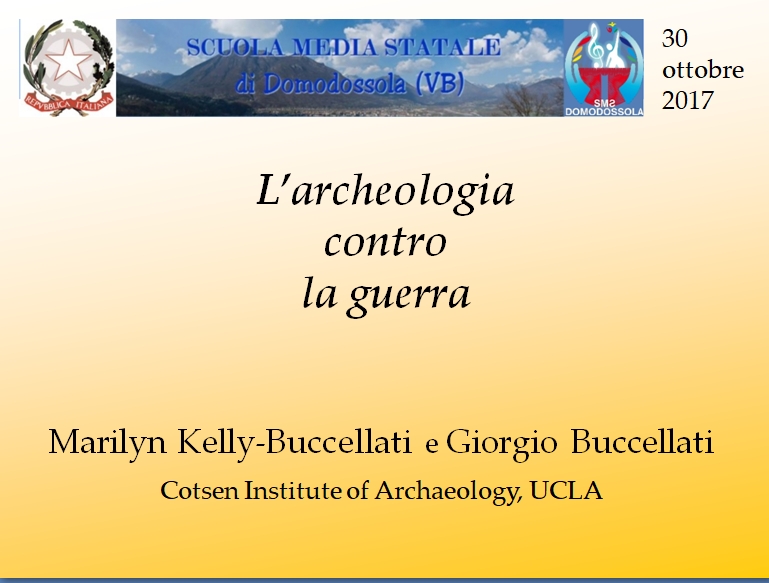
|
Marilyn Kelly-Buccellati and Giorgio Buccellati
“L'archeologia contro la guerra”
With this meeting the school project officially starts, involving dozens of students in Italy and Syria. In a hall packed of students, the directors of the archaeological excavation of Urkesh/Tell Mozan, Giorgio and Marilyn Buccellati, described to the children the site and its importance, not only for Syria but for the whole history of the development of civilizations in the ancient world. From now on, it will be up to the young people who have attended this meeting to question themselves, together with their educators, and to exchange provocations on themes related to the past, cultural traditions and the protection of the landscape.
|
November 10 – Biblioteca Comunale, Baceno
|
|
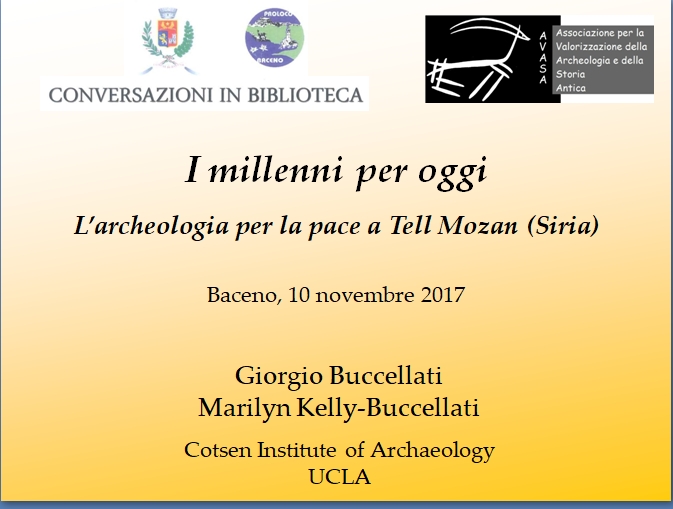
|
Giorgio Buccellati and Marilyn Kelly-Buccellati
“I millenni per oggi. L'archeologia per la pace a Tell Mozan (Siria)”
|
November 15 – American University of Beirut
|
|
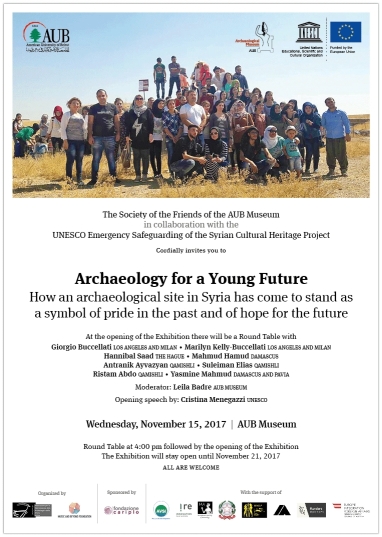
|
Giorgio Buccellati and Marilyn Kelly-Buccellati
“Archaeology for a Young Future”
How an archaeological site in Syria has come to stand as a symbol of pride in the past and of hope for the future.
|
December 1 – 'Urkesh musical group' (Domodossola)
|
|
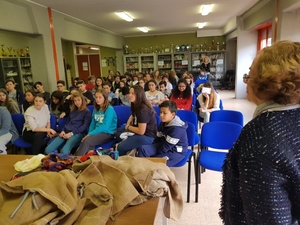
|
Giorgio Buccellati, Marilyn Kelly-Buccellati
“Lecture at the 'Urkesh musical group' in Domodossola”.
Giorgio and Marilyn Buccellati met the youngsters who had accepted the challenge of preparing a musical interpretation of the exhibition that we are preparing for Rimini. During the lesson, the Professors presented the excavation of Urkesh and the conservation techniques used on the site, but above all they provided an overview on the general situation of the area, explaining how the local population responds to the “provocation” of archaeology. The kids, under the guidance of Prof. Enzo Sartori, showed a lively interest and enthusiastically engaged in carrying out the project.
|
December 8 – Shanghai Archaeological Forum
|
|
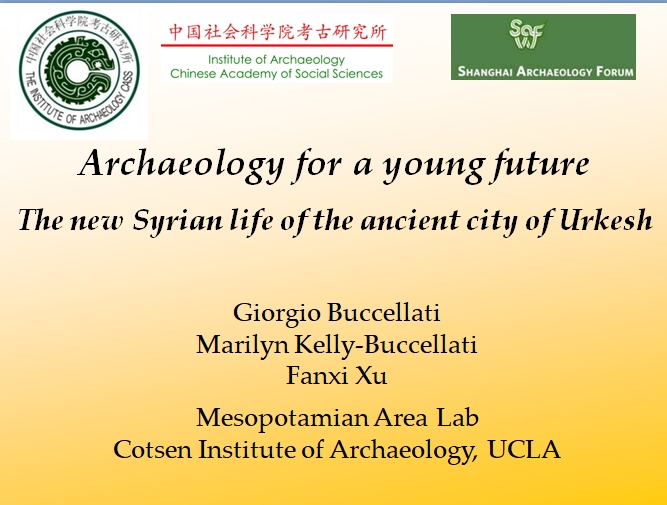
|
Giorgio Buccellati, Marilyn Kelly-Buccellati and Fanxi Xu
“Archaeology for a Young Future.
The New Syrian Life of the Ancient City of Urkesh”
|
December 13 – Institute for the History of Ancient Civilizations, Northeastern University, Changchun
|
|
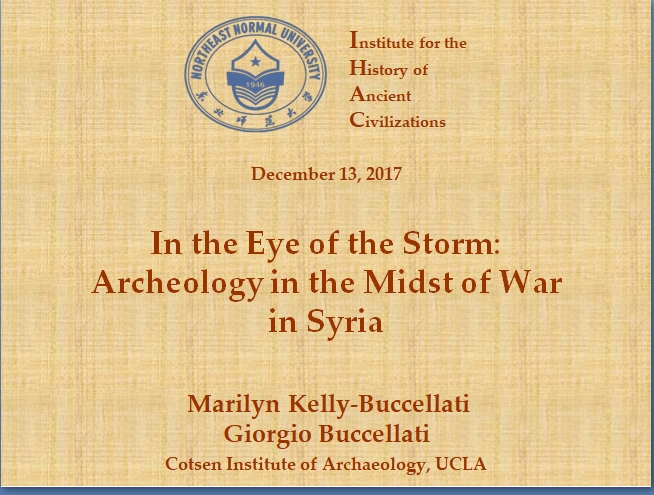
|
Giorgio Buccellati and Marilyn Kelly-Buccellati
“In the Eye of the Storm.
Archaeology in the Midst of War in Syria”
|
December 15 – Biblioteca Teresiana, Università degli Studi, Pavia
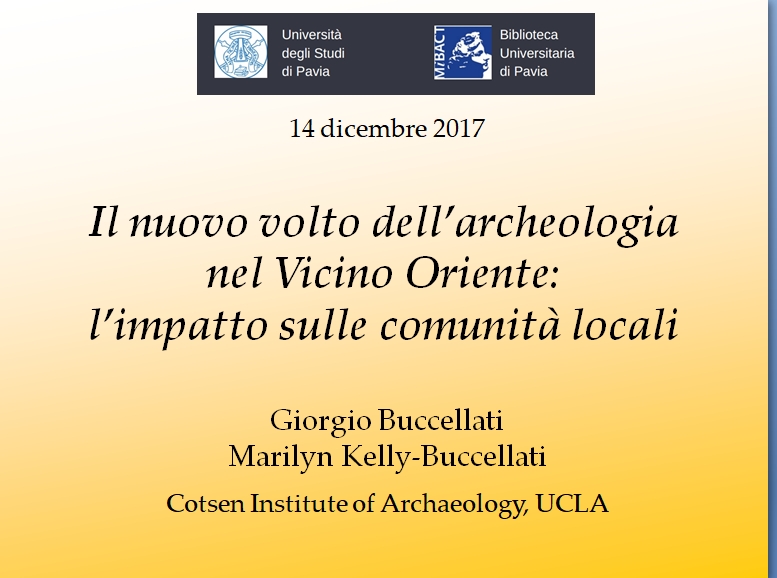 |
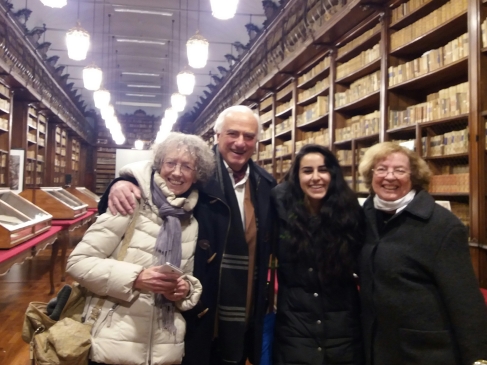
|
Giorgio Buccellati and Marilyn Kelly-Buccellati
“Il nuovo volto dell'archeologia nel Vicino Oriente:
l'impatto sulle comunità locali”
Two conferences on Urkesh have been held in Pavia; we were guests of Prof. Clelia Mora. Yasmine Mahmoud, a graduate student of the history program at the University of Pavia, came for the occasion from Damascus, and we see her here together with Prof. Mora, Giorgio Buccellati and Marilyn Kelly-Buccellati, in the “Biblioteca Teresiana”, the place of one of the two conferences. The other conference was given to a group of high school students, to whom we presented in particular our middle schools program.
|
Back to top
2018
January – Qamishli
|
|
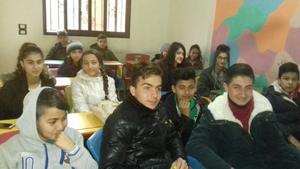
|
Giorgio Buccellati, Marilyn Kelly-Buccellati
“Urkesh at the Qamishli middle school”
In January, our project to raise awareness towards the past among the children started in Qamishli. Here are our first students, smiling and proud in their class where they meet in the afternoon to study English. The project currently involves a twinning with a music middle school in Domodossola, where three classes have already begun to reflect on the value of the past from the beginning of the 2017/2018 school year. We are sure that from this newly established dialogue we will all have much to learn, about ourselves and the younger generations.
|
March 28 – Durham University (UK)
|
|
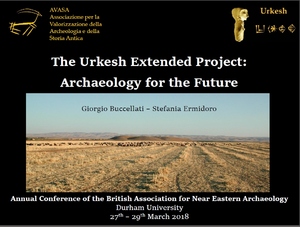
|
Giorgio Buccellati and Stefania Ermidoro
“Conference at the BANEA conference, Durham University (UK)”
Our project was presented at the annual conference of the British Association for Near East Archeology, BANEA. In particular, we have emphasized the three "pillars" on which our project is based: conservation of the archaeological site, research and education program, and support for the local economy. Always counting on the relationship of mutual trust that has been established over the years between the directors of the excavations with the local communities. The results obtained at Tell Mozan, despite the simplicity of the means at our disposal and the economy of the resources that we use, have been recognized also on this occasion as a unique example of resilience and presence on the territory.
|
June 18 – San Marino Republic (Villa Manzoni)
|
|
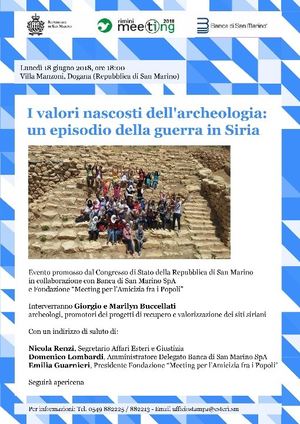
|
Giorgio Buccellati, Marilyn Kelly-Buccellati
“I valori nascosti dell'archeologia: un episodio della guerra in Siria”
[“The hidden values of archaeology: an episode of the Syrian war”].
In Villa Manzoni, in the Republic of San Marino, there has been a conference entitled “I valori nascosti dell'archeologia: un episodio della guerra in Siria” [“The hidden values of archaeology: an episode of the Syrian war”], promoted by the State Congress of the Republic of San Marino in collaboration with Banca di San Marino SpA and the Foundation “Meeting per l'Amicizia fra i Popoli” [Meeting for friendship among peoples]. In addition to the directors of the Tell Mozan/Urkesh project, Giorgio and Marilyn Buccellati, also Nicola Renzi (Italian Secretary for Foreign Affairs and Justice), Domenico Lombardi (CEO of the Banca di San Marino SpA), and Emilia Guarnieri (President of the Foundation “Meeting per l'Amicizia fra i Popoli”) took part to this initiative. This has been the occasion to discuss about the current situation in Syria and the role that archaeology can play in order to restore the profound value of the dispersed or destroyed cultural heritage, and give it back to the Syrian population.
|
June 23 – Leiden
|
|
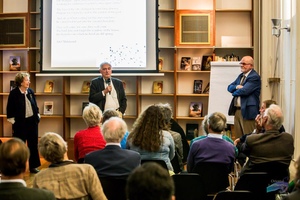 [credits: [credits:
E. van Nieuwland]
|
Giorgio Buccellati, Marilyn Kelly-Buccellati
“'Archaeology for Peace' in Leiden”
Once again, our project has been the protagonist of a major event: this time in Leiden, in the Netherlands. The university of Leiden, in collaboration with the associations “Ex Oriente Lux” and “Oriental Landscape Leiden” has invited the Profs. Buccellati to an entire day of debate and reflection about the topic “Archeology for Peace” [an abstract of the paper given by the Professors is available at this link]. The event included an exhibition on Urkesh which showed the latest projects carried out on the site together with the local communities, as well as a conference. Giorgio and Marilyn Kelly-Buccellati explained how Urkesh, today, is a symbol of pride in a shared past and a united future. The day has ended with an evening performance by the “New European Ensemble & Geert Mul”, with music inspired by the Syrian city of Palmyra.
|
November 14-17 – Denver (USA)
|
|
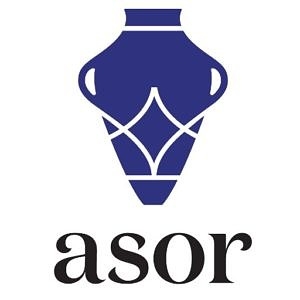
|
Federico A. Buccellati
“Research, Communication, and Identity in Times of Crisis: The Example of Tell Mozan”
Federico A. Buccellati attended the annual meeting of the American Schools of Oriental Research (ASOR) held in Denver (USA), with a presentation entitled “Research, Communication, and Identity in Times of Crisis: The Example of Tell Mozan”. A large audience composed of colleagues from all over the world could thus hear how the archaeological mission is still active in Urkesh, and be informed about the numerous activities constantly supported by AVASA.
|
Back to top
2019
March 14 – Kiel
|
|

|
Hiba Qassar
“Archaeology and Syrian Identity: 'Urkesh Gate', a good Tale from Syria”
On the occasion of the International Workshop Socio-Environmental Dynamics over the Last 15,000 Years: The Creation of Landscapes VI, at the German University of Kiel, Hiba Qassar gave a lecture entitled “Archaeology and Syrian Identity: 'Urkesh Gate', a good Tale from Syria”. The conference raised considerable interest, and it prompted a discussion on the possibility of following the example of Mozan as a method to be applied in other Mediterranean sites. At this page you can find a description of the event by Hiba Qassar.
|
May 15 – Berlin (FUB)
|
|
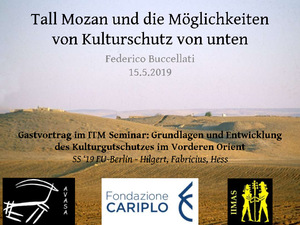
|
Federico A. Buccellati
“Tell Mozan and the possibilities of cultural protection from below”
“Tell Mozan and the possibilities of cultural protection from below”. This is the title of an invited lecture given by Federico A. Buccellati at the Freie University in Berlin, within the frame of a Seminar entitled “Basics and development of cultural property protection in the Middle East”. Federico A. Buccellati has provided evidence of the efficient Site Preservation Project carried out at Tell Mozan, also addressing wider issues such as Cultural Heritage and Community Archaeology.
|
December 14 – Shanghai
|
|
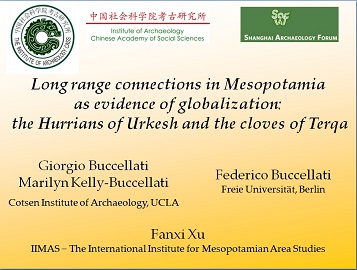
|
Fanxi Xu
“Long range connections in Mesopotamia as evidence of globalization: the Hurrians of Urkesh and the cloves of Terqa”
“Fanxi Xu, a collaborator and former member of the Tell Mozan archaeological mission, has given a paper in Shanghai entitled “Long range connections in Mesopotamia as evidence of globalization: the Hurrians of Urkesh and the cloves of Terqa”. The presentation, written in collaboration with Federico A. Buccellati, Giorgio Buccellati, and Marilyn Kelly-Buccellati, analyzes the existing geographical links in the so-called 'Outer fertile crescent' on the basis of the archaeological findings made in the two sites.
|
Back to top
2020
June 11, 16, 23 – Università degli Studi di Napoli “L'Orientale”; ISMEO - Associazione Internazionale di Studi sul
Mediterraneo e l'Oriente.
|
|
|
Flyer
Matteo Delle Donne
Ciclo di seminari/Cycle of lectures
“Lo sfruttamento delle piante durante la protostoria/Plant exploitation during protohistory”
1) Lo sfruttamento delle piante in Africa nordorientale tra IV mill. a.C. e I mill. d.C. L'apporto di nuove riflessioni tra archeobotanica e numismatica/Plant Use in Northeastern Africa between the 4th mill. BC and the 1st mill. AD. New Reflections between Archaeobotany and Numismatic (11 June 2020);
2) Ricerche archeobotaniche nel Vicino Oriente Antico. Uno sguardo al Kurdistan siriano/Archaeobotanical Research in Ancient Near East. A Glance to the Syrian Kurdistan (16 June 2020);
3) Ricerche bioarcheologiche a Shahr-i Sokhta: legni, semi e tessuti/Bioarchaeological Research at Shahr-i Sokhta: Woods, Seeds, Fruits, and Textiles (23 June 2020).
Italian abstract (by Matteo Delle Donne):
“Il ciclo di seminari dal titolo Lo sfruttamento delle piante durante la protostoria intende fornire alcuni strumenti teorici e metodologici indispensabili per la comprensione dell'antico rapporto tra l'uomo e l'ambiente, mediante la presentazione di casi di studio specifici, tra Africa nordorientale, Vicino e Medio
Oriente, di ambito protostorico.
L'analisi e lo studio delle numerose attestazioni di resti vegetali provenienti dai contesti archeologici indagati da missioni italiane tra Egitto (Naqada), Sudan (Kassala) ed Eritrea (Adulis) ha fornito la possibilitàdi approfondire la nostra conoscenza in merito a un importante aspetto del passato. Inoltre, lo studio delle raffigurazioni di spighe di cereali sulle monete del Regno di Aksum può fornire nuovi utili elementi di riflessione relativi all'importanza della coltivazione di cereali nell'agricoltura etiope, sia al giorno d'oggi che in passato.
Lo studio dei resti di piante dal sito di Tell Mozan (Siria nordorientale) ha reso possibile ottenere nuove informazioni su quel peculiare rapporto che la comunità antica insediata nella regione attraversata dall'Alto Khabur ha instaurato con l'ambiente nel quale era inserita. A tal fine, ci si è avvalsi di un approccio interdisciplinare che ha consentito di tracciare una parte dell'evoluzione del mondo vegetale, mediante lo
studio dei resti di semi e frutti provenienti dagli scavi del sito. La ricerca, quindi, integrando le informazioni provenienti da fonti archeologiche e archeobotaniche, ha consentito di ricostruire il quadro del paesaggio ecologico e culturale di una parte della Jazira siriana sul finire della protostoria.
Il sito di Shahr-i Sokhta è uno dei più importanti archivi della biodiversità antica dell'Iran sud-orientale, nel quale sono state ampiamente registrate le interazioni tra piante, animali e comunità umane che hanno vissuto, per circa due millenni, nell'insediamento. Al momento delle prime indagini condotte nel sito, nel
1967, la diffusa presenza di resti di piante e animali nel deposito archeologico ha posto gli archeologi di fronte alla necessità di ampliare il campo delle indagini archeologiche, estendendole alle scienze naturali. Lo studio dei materiali organici di questo sito ci ha permesso di conoscere le specie legnose utilizzate nell'insediamento per gli scopi connessi alla vita quotidiana degli abitanti, di ricostruire l'antica agricoltura e di approfondire l'antica produzione tessile e l'artigianato degli abitanti del Sistan durante il III mill. a.C.”
English abstract (by Matteo Delle Donne):
“The cycle of lectures entitled The exploitation of plants during protohistory aims to provide some theoretical and methodological tools needed to understand the ancient relationship between man and the
environment, through the presentation of specific case studies, among Northeastern Africa, Near and Middle East, in protohistoric times.
The analysis and study of a great number of plant remains from the archaeological sites investigated by Italian expeditions among Egypt (Naqada), Sudan (Kassala), and Eritrea (Adulis) allowed to deepen our knowledge about a particular aspect of the past. Moreover, investigation on the cereal ears depicted on Aksumite coins provided new elements of reflection for understanding the importance of cereal cultivation in Ethiopian agriculture, both today and in past.
The study of plant remains from Tell Mozan (northeastern Syria) made it possible to obtain new information about the peculiar relationship between the ancient communities settled in the Upper Khabur region and their own environment. In order to achieve this goal, an interdisciplinary approach has been adopted, which has shed light on the evolution of the plant world, through the study of the botanical macroremains from the archaeological site. Thus, the ecological and cultural landscape of a part of the past Syrian Jazira has been reconstructed, by integrating the information coming from the archaeological features and the archaeobotanical remains.
The site of Shahr-i Sokhta is one of the most important archives of the past biodiversity of southeastern Iran where the interactions between plants, animals, and the human communities that lived in the settlement over about two millennia have been recorded. At the time of the first archaeological excavation of the site, in 1967, the diffuse presence of plant and animal remains in the archaeological deposit placed archaeologists in front of the need to widen the field of archaeological investigations, extending them to the natural sciences. The study of organic materials from this site allowed us to know the wood species used in the settlement for the daily life of the inhabitants, to reconstruct the ancient agriculture, and to identify the ancient textile production, and craft of the inhabitants of Sistan during the third millennium BC.”
|
November 11 – CAMNES You Tube Channel;
CAMNES - BuNEER 2.
|
|

|
Giorgio Buccellati, Marilyn Kelly-Buccellati et al.
“Urkesh beyond Urkesh: Community and Digitality”
Video You Tube (CAMNES)
Brief presentation (by Valentina Santini, CAMNES):
“Excavations of ancient Urkesh have been on halt for the last nine years, but another kind of Urkesh has emerged during this time of crisis, It is in the first place an Urkesh that has been re-embedded in modern consciousness, through an extensive project of community archaeology, and it is, in the second place, an Urkesh that has been transposed into a new kind of digital existence. We will present both aspects, with special emphasis on the innovative Urkesh Global Record which proposes a methodological approach whereby excavation and publishing are merged into a single process.
Speakers and sections (in order of appearance):
- Intro (Valentina Santini) 0:00
- Marilyn Kelly-Buccellati, Los Angeles 6:54
- Giorgio Buccellati, Los Angeles 12:24
- Amer Ahmad, Qamishli 18:38
- Giorgio Buccellati, Los Angeles 25:05
- Marilyn Kelly-Buccellati, Los Angeles 28:42
- Stefania Ermidoro, Treviso 35:15
- Yasmine Mahmoud, Damascus 40:56
- Hiba Qassar, Florence 45:22
- Elleni Gizas, Corinth 49:30
- Qin-Yu, Xi'an 54:00
- Samer Abdel Ghafour, Rome 56:49
- Giorgio Buccellati, Los Angeles 1:03:55
- Lorenzo Crescioli, Florence 1:11:01
- Yingshan Guo, Nanjing 1:16:45
- Amer Ahmad, Qamishli 1:20:39
- Marilyn Kelly-Buccellati, Los Angeles 1:23:00
DISCUSSION 1:27:58”
|
Back to top